*Title Reference
For many generations the question of the origin of the American Indian has aroused great interest, and archaeological and ethnological evidence is being continually sifted in the hope of finding a partial answer. Significant clues are furnished by the Indians’ musical instruments. Of these, there were a great number, extremely varied in design, but limited to certain basic types. The vast majority were designed primarily for emphasizing rhythm rather than melody, and are thus clearly associated with the dance. Now, the dance of peoples in the stage of cultural development reached by the pre-Columbian Indian was primarily a ritual practice, a fact which tended to maintain stability in the forms of the musical instruments used as its accessories. It is this stability of form, this resistance to change, which makes it possible to view musical instruments as mirrors of the past, reflecting images of other lands and other times.
Acceptance of this concept of musical instruments as representatives of the “living past” has led to their study as an element which might help to determine the origin of the Indians. For, throughout the primitive world, there recur counterparts of these same instruments, some almost duplicating North American ones, while others reveal only similarity with the basic types. Here, a number of these instrumental parallels are gathered together and presented without interpretative comment, to entertain the curious and delight diffusionist detectives.
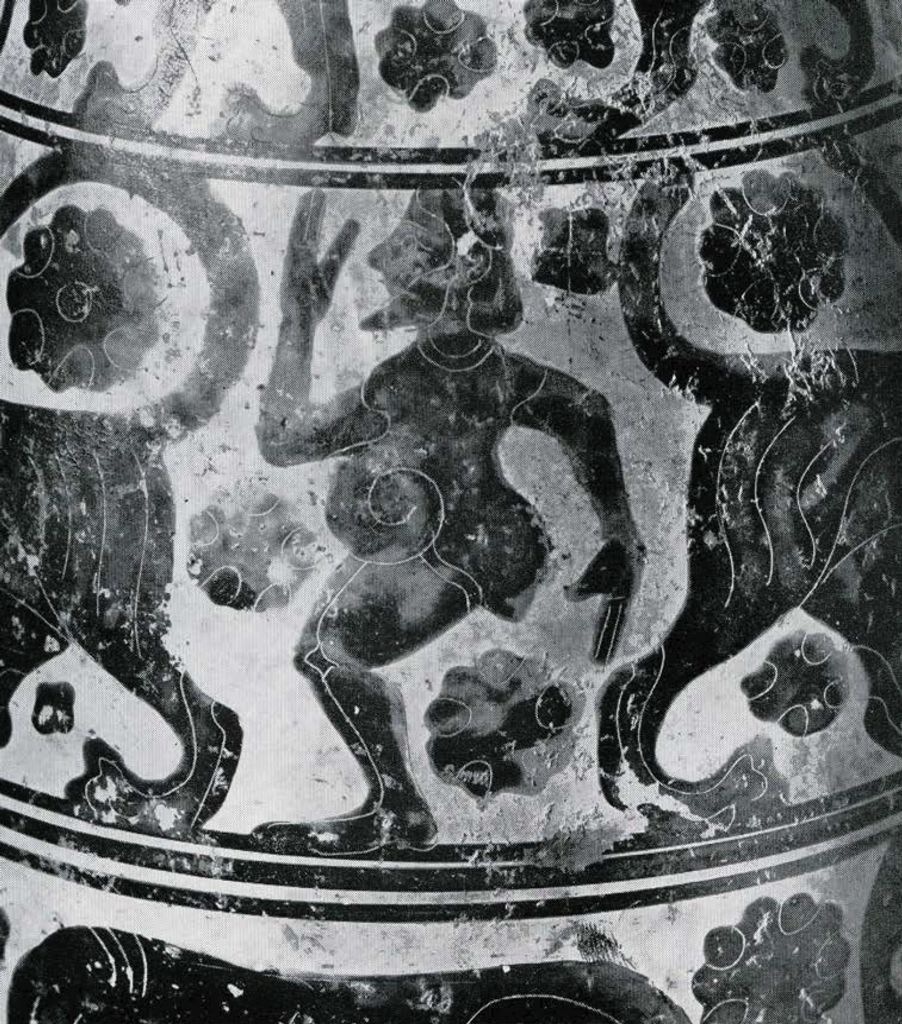
Museum Object Number: MS553
Image Number: 46755
IDIOPHONES
An idiophone is a musical instrument which produces its sound through the vibration of its own naturally sonorous body. Of all the types of Indian instruments, this is the most common, fashioned in almost infinite variety. Idiophones fall into three basic types: (1) prototypical idiophones, which produce sound through the direct striking of hands or feet upon a non-sonorous or slightly sonorous object; (2) intermediate idiophones, which produce sound through adding, to the hands or feet, an extension which beats upon a non-sonorous or slightly sonorous object; (3) true idiophones, which produce sound through the striking of a naturally sonorous body.
PROTOTYPICAL IDIOPHONES
Body-Striking, Undoubtedly, the earliest “musical” accompaniment was supplied by the human body itself. The flesh was struck, the feet were stamped, the hands were clapped for the sole purpose of emphasizing the rhythm of the ritual song and dance, and of enhancing the emotion underlying such activity. That striking the body is an ancient practice is clearly corroborated by paintings on Greek vases (Fig. 1) showing dancers striking their buttocks. Yet, as late as the 1890’s, a ceremonial dance of the Hare Indians, following the killing of a bear, found a dancer passing around the fire, striking his right buttock with one of the bear’s paws. And the Arrow Dance of the Vedda of Ceylon has an accompaniment of beating on the belly, thigh, or buttock, with a howling song as a vocal refrain.
More common is the striking of the thighs as an accompaniment to dance or song. This is seen among the Vedda, while the Tonto Apache, when dancing, stamped around clapping their hands and slapping their thighs. At the semi-annual Acorn Sing of the Yuki, which complemented the girls’ puberty dance, pleased the gods, and assured abundant harvests, the Acorn songs were sung by seated or standing men, who patted their thighs in unison (though they did not dance on this occasion). The Ikogmiut Eskimo held a Great Feast for the Dead, on the third and fourth day of which the dancers stamped their feet and slapped their thighs. Wiping motions, followed by the stamping and slapping of the thighs, indicated that the dancers thus cast off all uncleanness that might be offensive to the shades, making their offerings acceptable. In New Zealand, the nocturnal war dance began by the dancers’ stamping the ground and then striking their palms on their thighs for about a minute, after which they contorted their bodies, grinned frightfully, and cast imprecations and abuse on their supposed enemies, as if to defy them in battle. The inhabitants of Pitt Island in the Gilbert group had a dance accompanied by the clapping of hands, which were afterwards slapped with great force against thighs and breast, while the body rocked to and fro.
The chest is struck in both the Old and the New World. In the Satukhota song series of the Mohave Indians, the singer smote his palm against his breast. Men sitting about in the sweat house of the Shasta chanted in low tones and struck their chests gently with their palms. Capt. James King, who was with Capt. James Cook when the latter discovered the Hawaiian Islands in 1778, wrote of the Hawaiian dances being prefaced with a slow solemn song, in which all joined, moving their legs and gently striking their breasts in an easy, graceful manner. In the spirited Hawaiian hula pa’i-umauma (“chest-beating hula”) there was a frequent smiting of the chest with the open hand, and a strenuous movement of the pelvis and lower part of the body. Striking the breast on Pitt Island has been described above.
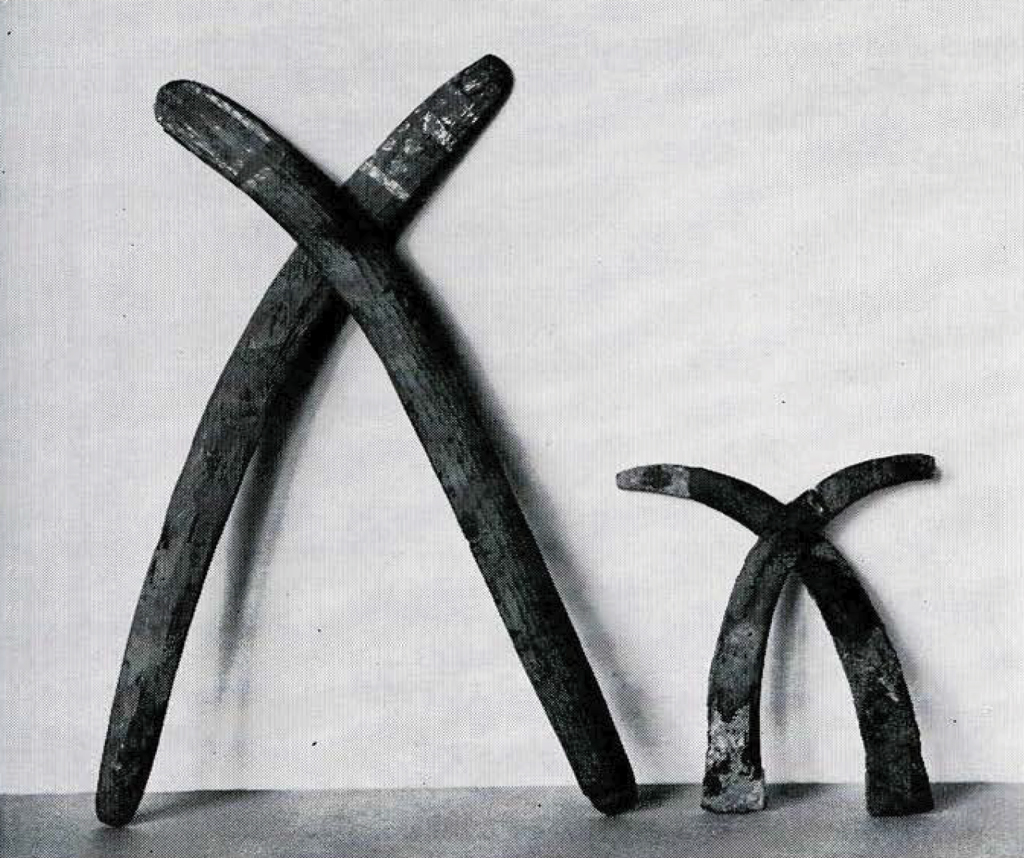
Museum Object Numbers: 31-34-158 / 31-34-162
Figure 3. (right) Concussion sticks. Fara, bronze clappers.
Museum Object Numbers: B19862 / B19863
Image Number: 46938
Hand-Clapping. This is a widely diffused musical phenomenon, ranging from Australia, Micronesia, and Polynesia up to the Vedda of Ceylon and the Andaman Islands; from Madagascar through most of Africa; and in northeastern Siberia. Usually hand-clapping is merely a rhythmic accompaniment to the dance or song, appearing alone or as an auxiliary to other instruments. But hand-clapping is also employed non-musically: as a charm, salute, or signal of some sort. All of these uses, both musical and non-musical, coincide with the practices of the North American Indians.
Unmarried Ba-Ronga girls of South Africa have a game in which they address an incantation to a big grey lizard. A girl approaches it, claps her hands under its nose, and sings, “Big lizard, lift up your head!” The lizard is so fascinated by the song that he stretches his neck and swings his head to and fro during the whole time the girl claps. Among the northern clans of this same tribe, salutations are generally accompanied with a clapping of hands. Men beat their hands against each other, putting them parallel to each other; women do the same, putting them crosswise or at right angles. Among the Ba-Ronga, clapping the hands is also a sign of thankfulness. A Ba-Pedi man greets a gathering of men by clapping hands before his breast, but when only one person is saluted, the greeter bows down and claps his hands at the height of his knees. In the Fiji Islands, a crown orator made it known that he was about to address a gathering. Everyone immediately became seated and a simultaneous signal, hand-clapping and a hollow nasal whoo, showed that all were attentive. The Chukchee have incantations for improving bad weather in which hand-clapping plays an important role.
Among the Indians, hand-clapping is found mostly along the periphery of the continent, occurring in the Southwest, California, the Northwest Coast, and thinning out across the great northern reaches. It has been reported in the Virginia-Maryland area also. In this continent, as elsewhere in the world, the primary function of hand-clapping is as an accompaniment to the dance or song, a source of emotion-rousing rhythm.
Hand-clapping has both supernatural and secular functions. The Western Achomawi and the Foothill Maidu consider a falling star as the sign of an earthquake, an evil portent, greeted by hand-clapping and loud breathing. The Mountain Nisenan, the Eastern Shasta, and the Modoc, as a precaution against a whirlwind, talk to it while clapping their hands and stamping their feet. While a Twana man plays in a gambling game, the other members of his party beat a drum, clap hands, and sing, each one singing his own tamanous song to invoke the aid of his special guardian spirit. The chief formulist in the Karok World-Renewal cere- mony jumps to the ground from a certain rock. At the sound of his landing, which is the signal for the crowd to look up, they all clap hands. This ritual ensures long life and good luck. The Roanoke Indians clapped their hands with their tobacco offering. At the Tolowa girls’ puberty ceremony, the virgin was brought before the people, wrapped like a corpse in a deerskin. This was done to satisfy Sickness by making it think it had accomplished its purpose and secured a body. She stood before them a short time, the skin was removed, and she resumed her seat. At daylight, the people ran to the river to bathe and when they came out and stood on the bank, they clapped hands and shouted, “He . . . ! Sickness go away!” Wa-ts’Em-mō’, the representative of a Tsimshian supernatural power, responds only when called by a young child of high rank. Then the people shout, clap hands, and beat drums. This supernatural power is used for all the children of high rank to impress upon them that they shall not answer any one quickly who should offend them. In the Yurok narrative (A Doctor Acquires Power) the clapping of hands as a signal to stop the singing of a song is mentioned several times.
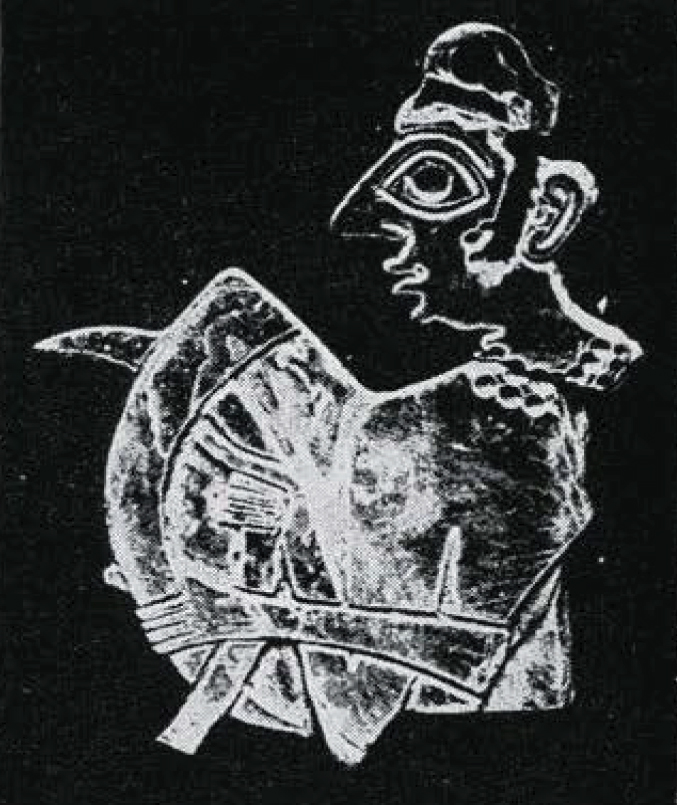
Foot-Stamping. More extroverted than both slapping the body and clapping the hands is the practice of stamping while dancing. This is closely related to the dance itself, for many of the actual movements of the ritual dance consist of raising and lowering the feet forcibly. Footstamping is a widely distributed action-one might say universal in its geographical and temporal occurrence. It is employed in the corrobborees of Australia, where the accommodation of stamping to the different tempi of the various songs can stimulate the participants to great emotional intensity. In northwestern Australia, the Larrekiya girls’ puberty initiation ceremony is celebrated in part by a chant, consisting of a long-drawn-out “ya, ya, ya,” and with a shuffling dance, punctuated by the feet of the female participants. In New Zealand, foot-stamping was used to accompany the war dance by which the dancers aroused themselves to feverish pitch prior to battling the enemy. In the Loyalty Islands, certain of the dances were accompanied by stamping, while in New Guinea the men accompany songs with either a long hand drum, two strings with mussel-shell bells attached, or stamping the earth with their feet. On Banks Island, it is the men who stamp their feet for the dancers. In Asia, on the Kamchatka peninsula, both men and women dance in imitation of the movements of sea-dogs and bears, singing to their dancing and stamping upon the ground in a very expressive manner. Slightly farther inland, the Yukaghir strike the ground with both heels while dancing. In Africa, the Thonga nation mark the rhythm with foot-stamping on the ground at regular intervals. During the coronation of a chief, this tribe employs a soloist with a chorus of warriors who strike their shields with their weapons, stamping their feet at the same time. In South America, the Arhuaco Indians of Colombia have a simple round dance with men and women stamping the earth. In Venezuela, the Motilon men dance forward and backward, stamping their feet and blowing upon their two-toned notched end flutes of bone.
In North America, this trait is extremely widely distributed. There is hardly an area in which stamping does not occur. However, certain modifications are found which use true idiophones, such as stamping upon a plank in California; stamping on the wooden floors and kicking the wooden walls of the dwellings among the Northwest Coast Indians; the tying to the legs of rattling agents such as sleigh bells among the Plains Indians, cocoons among the Indians of the Southwest and southern California, and tortoise shells filled with pebbles or corn in the Southeast and Southwest. In almost every case, these are used to emphasize the rhythm of the dance.
Among the North American Indians there are four non-musical categories of foot-stamping: (1) stamping as a supernatural aid; (2) a vague connection with food, probably supernatural in origin; (3) foot-stamping in pantomime and (4) foot-stamping used non-musically in ceremonials. Illustrative of the first category is the Great Feast of the Bering Strait Eskimo, during which the dancers suddenly stop in the midst of their movements and stamp on the floor, alternating their feet, placing their hands on their shoulders, and bringing them down as though wiping off some unseen thing. This is clone to wipe off any uncleanness that might offend the shades of the dead. This same people send their shades back to their abiding place from the Annual Feast by the simple expedient of stamping on the floor. The Chnagmiut Eskimo dancers, like the preceding, cleanse themselves by stamping heavily on the floor. The Chinook have a myth wherein stamping on the beach caused a certain chief to sink into the ground. Among the Wahpeton Dakota, the conjuror stood over a sick person, shaking his gourd rattle, and uttering the most horrible sounds of which the human voice is capable. These utterances were accompanied by stamping and violent contortions of the body. For Nisenan and Shasta usage as a precaution against the whirlwind, see page 6. Among three of the cults of the Oglala Sioux, foot-stamping is found to be related to the supernatural. At the Elk Cult ceremony, the dancers, performing around the camp circle, stamp a foot and flash sunlight from a reflector at persons who enter their sight. This is supposed to put the victims in the power of the Elk Cult. The Black-Tail Deer Cult have bells on their legs to ring and emphasize the stamp when they shoot magic. In the regular ceremonies of the Buffalo Cult, while the drumming was going on, the members would bellow like buffalo and some would stamp a foot, leaving buffalo tracks upon the ground. Okinagan and Paiute shamans used the supernatural power of the foot-stamp as part of their curing rite, while a Bear River, California, female shaman, in a modern curative dance, stamped on the floor in time to the music as a part of her supernatural procedure. The Shuswap have a myth in which the stamping of a giant’s foot caused the ice to tremble and to throw back into the water the fish caught by a Shuswap fisherman.
The second category of foot-stamping-in some supernatural connection with food-is apparently limited to the Eskimos along Bering Strait. At the Asking Festival of the St. Michael Eskimo, the hunters and large boys, in single file and with wooden dishes in their hands, visit each house in the village. The women have large tubs of berries and other food waiting for them. The procession of men and boys files into each house, all holding out their dishes while they stamp their feet and utter grunting sounds. The women at each house place food in every dish, and when the round is completed, the men and boys return to the kashim, shouting and stamping. At the Bladder Feast of the Kaialigmiut Eskimo, a man, stripped to the waist, bore a wooden dish of food, which he held high over his head, and circled once around the room as an offering to the shades and tunghat in the sky land; then he stamped on the floor two or three times and the people came in, bringing food, of which he partook.
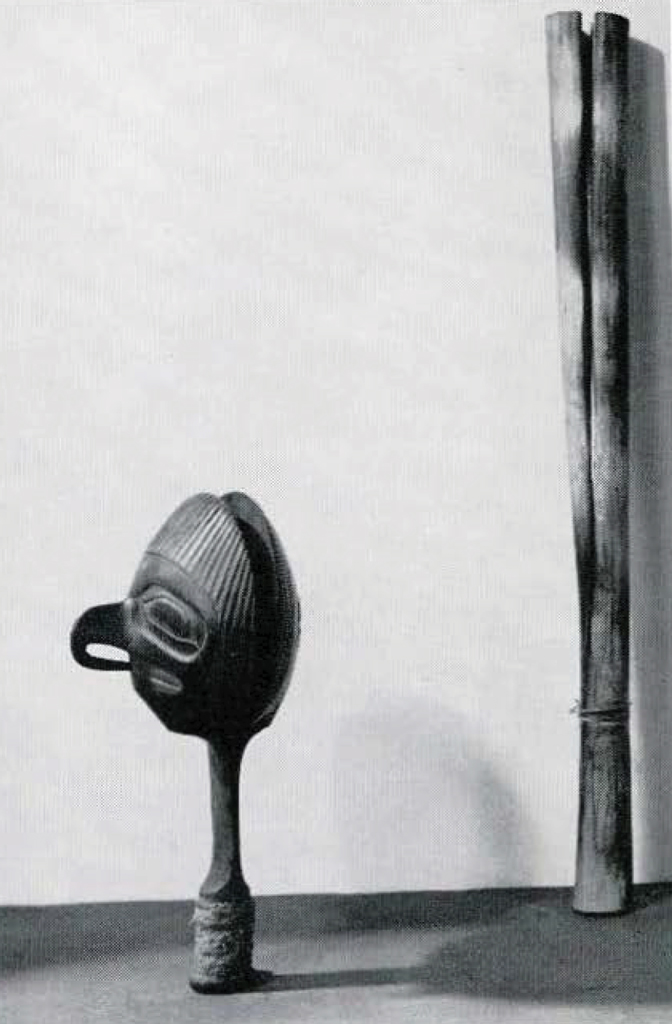
Museum Object Number: 37724
Figure 6. (left) Hand clapper, Tlingit.
Museum Object Number: NA4965
Image Number: 46939
A third category is the occurrence of foot-stamping in pantomime. During the third day of the Great Feast for the Dead at Razbinsky, the Ikogmiut Eskimo witnessed a pantomimic entertainment by two men. The first imitated walking on snowshoes by his outstretched hands, stamping heavily at the same time with his right foot. The second imitated a walking bear, with foot-stamping on the floor as a prominent feature of his rendition. At a Buffalo Dance held at the Crooked Lake Agency, Saskatchewan, for the purpose of securing an abundance of buffalo, and not to cure the sick, the Qu’Appelle River Cree danced in imitation of the action of the buffalo, bellowing, stamping, and hooking the ground.
The fourth of these non-musical categories of foot-stamping might be termed the ceremonial aspect; this is similar to the first category, except that the relations to the supernatural have become traditional, and the meaning of the actions has been lost. For example, on the tenth day of the World-Renewal ceremony, the priest of the Karok living at Katimin stamps five times (a mystical number) with his right foot as he walks out of the area. An informant from Panamenik believed that stamping with the right foot meant “stepping on the world.” The fourth day of the Mandan Okipa ceremony witnesses the stamping of feet accompanying each of the four moves (Mandan mystical number) of the sacred “turtles,” which are specialized drums used by this group only. When the Land-Otter dance was given on the fifth day of the great Nootkan Winter Ceremony, a canoe happened to approach the beach. Two men waded out into the water to prevent the canoe from landing, and the dancers and spectators on the beach all beat their feet rapidly on the ground, while some of them leaped and tumbled about like otters on a slide. Then all rushed toward the canoe and splashed water in it until it sank. The visitors swam ashore, and were placed just inside the door of the house, with two men holding long poles crosswise to protect them from the otters. The people and the dancers now made the usual motions with their hands and beat the floor with their feet. During the Hopi Snake-Antelope ceremonies, which alternate with each other each year, fifteen males filed in and around the plaza four times, shaking rattles without singing, and stamping on the plank foot chum when the sacred meal is sprinkled. At the Zuni Ceremony for Snow, and also during initiation by the Wood Society, the chief goes alone to the court on the fifth morning to swallow his stick. At each of the four directions, and the zenith and nadir as well, he swallows the stick, stamping repeatedly each time before swallowing.
In the California area there is an entire complex of foot-stamping related to the victory dance of a returning war party. The Atsugewi, Klamath, and Modoc stamp one foot at this event while the Maidu, Shasta, Sinkyone, Wintu, Wiyot, and Coast Yuki stamp both feet.
INTERMEDIATE IDIOPHONES
There occurs a time in the development of man when he strives to overcome natural handicaps by the use of some mechanical means. With musical instruments, primitive man increased the scope of his rhythmic accompaniments by employing either extensions to his limbs or by using an object which could be struck or shaken, producing sound in its own right. This extension stage is here called “intermediate” idiophones, and lies between the prototypical and the true idiophones.
Ground-Striking. The first of the intermediate idiophones is the act of striking the ground with a beater of some sort. In Australia, the ground was struck by two sticks as a rhythmical accompaniment to a song. In Africa, the Ba-Ronga believe that rain comes from the gods, so that if the spring showers are late, men will go to the sacred wood where the ancestors have been buried to sing an ancient mourning song, while some of them beat the graves with sticks.
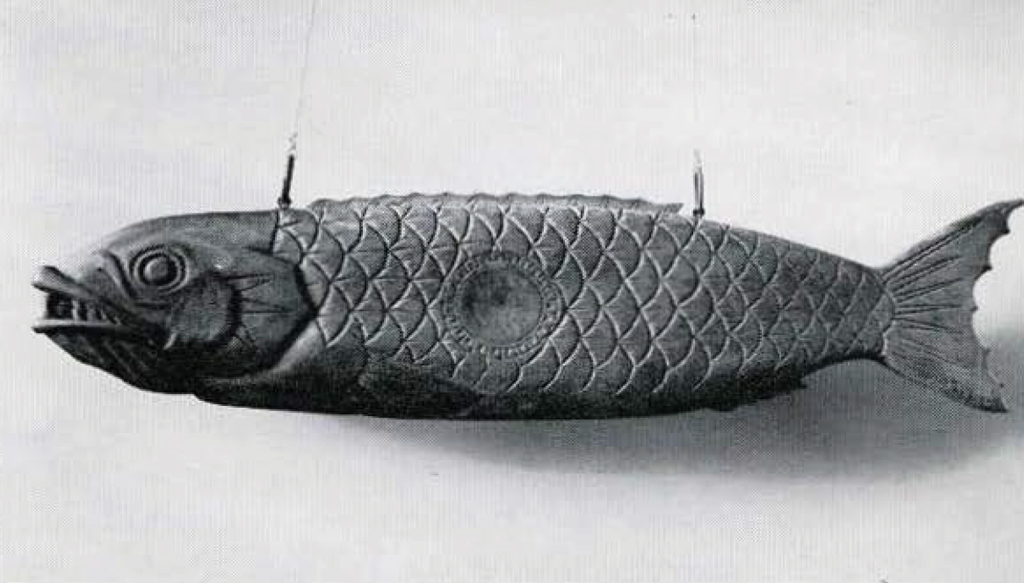
Museum Object Number: A656
Image Number: 46940
In North America, striking the ground is more frequently found, with great variation in its practice. For purely musical purposes, the ground is often beaten as an accompaniment along the Northwest Coast and in the Mackenzie-Yukon area, while occasional examples are found among the Plains and California tribes. Sometimes a rattle of some sort is beaten against the ground instead of a simple stick or club, this additional sound enhancing the rhythmic motor impulse. Thus, members of the Bûngi Chippewa Cannibal Cult enter the house of a sick person where they perform before the invalid, pounding their rattles on the ground, singing, whistling, and dancing. The leader of the Paskwawininiwug Masked Dance marks the beat for the singing by stamping on the ground his rattle-staff, a five-foot stick encased in an envelope of hide to which deer hoofs are attached. The Pomo strike a seven-foot stick with cocoons attached to the end upon the ground to beat time. Tlingit dance leaders might carry a thick staff with sea-otter teeth attached which were struck upon the ground to mark the measure. A Tsimshian shaman, treating a sick person, marches to the graveyard and strikes his globular wooden rattle upon the ground where the corpse of a relative of the sick person is found.
Ground-striking has a supernatural connotation in the Northwest Coast and Mackenzie-Yukon regions. At the Fishing Ritual of the Quileute, a stick, supposedly placed by the guardian spirit of the novitiate, is used with the singing of a song called walā’axwalā’s (“pounding with the stick”). Death, among the Tahltan, is announced in a loud voice by one of the men of the family, whereupon all assemble and strike the ground with sticks. This is to enable the spirit to “keep the trail.” In the Winter-Dance Ceremony of the Sanpoil-Nespelem, the shaman gave the novice something to hold during the dance. This might be a short stick which was to be held in a certain way, or swung from side to side, or tapped on the ground. That which was given was symbolic of the person’s spirit. The Tanaina “devil stick,” slightly less than shoulder high, is a regular part of the shaman’s equipment. It is used to drive out the evil producers of physical ailments and spells. During the course of his dance, the shaman strikes the ground two or three times with it, thereby effecting his patient’s release. The Northwest Coast tribes strike the ground as a signal. When two Haida at potlatch-time wish to be tattooed by the same chief, they beat the ground with a baton and mention the chief’s name. The initiated were invited to the Massett Haida’s Gū’gadōt feast by tapping the ground in front of them with canes, not by word of mouth. The Nootka Winter Ceremony finds the dancers making four circuits of the room, each circuit being accompanied by the repetition of a song, and at each ending the baton-master strikes the ground with a long speaker’s staff, crying, ”Strike twice! Make a noise!” In the potlatch ceremonies of this region, the names of the recipients of the gifts were called in order of rank and an attendant deposited each gift in front of this recipient; the host signified approval by thumping the ground with his baton.
A purely utilitarian use of ground-striking is that of the Achomawi and the Northern Paiute, who employ the practice as a game call when hunting mountain sheep.
In the origin myth for the Hidatsa Stone Hammer Society, some older men were selected as musicians. At first they had no drums, but merely hit the ground with a stick; later they got a drum. This myth affords a correct picture of the chronological placing of the intermediate idiophones in relation to the using of drums.
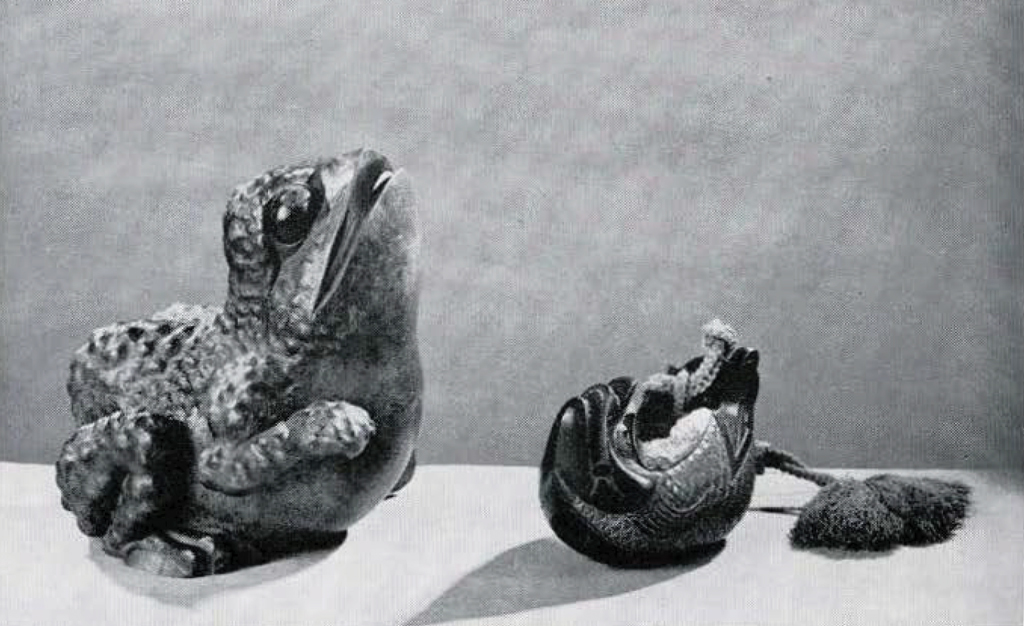
Museum Object Number: 11159
Figure 9. Percussion vessel in form of fish. Japan.
Image Number: 46941
Beaten Skin. A further step toward a more advanced instrumental type is the striking of a skin which, when stretched over a pit, leads directly to the drum. Skin beating has both musical and non-musical aspects, but its use as a musical accompaniment far outweighs its non-musical attributes.
In both Australia and Africa, skins are beaten predominantly by women, while in America, men are usually the performers-except among the Comanche and Kiowa, where both men and women participate.
Skins may be struck when rolled, folded, or stretched; and all three of these types are found in both the Old and the New World. In Australia, the women drum on a rolled skin rug held between their thighs, while, in America, the Apache, Arikara, Hidatsa, Mandan, and Pawnee all strike rolled hides. Folded skins are beaten in Australia and, in America, among the Arikara, Delaware, Huron, and Paskwawininiwug. Among the Pueblo Indians, the Hopi, Isleta, Laguna, and Zuni use skin bundles at their ceremonial dances. The stretched skin is the most usual. In Greenland, the Angmagsalik Eskimo shaman uses a small rough piece of skin which he holds tightly in the hollow of his hand while he strikes or raps it with a carved wooden stick held in his other hand. In French Equatorial Africa, the women strike the skins that serve them as clothing during the Kubandwa, the great initiation ceremony. In America, a piece of rawhide skin-usually buffalo hide-is struck by sticks throughout the Plains area. Among the Kutenai, some of the younger Indians, when travelling on horseback, sing refrains with an accompaniment of slaps upon the flanks of the horse-an example of striking a living skin other than one’s own as a musical accompaniment.
In certain cases the skin is filled with a padding, such as the grass-filled hide cushion of the Australian Dieri and the rice-filled leather roll of the Chinese (po foù). In America, the Arikara Young Dogs Society use pillows of tanned deer or elk hide, stuffed with buffalo hair; the Oklahoma Delaware fill a dry deer hide with dried grass at their Annual Ceremony; while such Pueblos as those at Isleta, Laguna, and Zuni use a bundle consisting of different kinds of clothing or cloth, or of jewelry wrapped very tightly in a buckskin (nowadays a canvas wagon cover) .
Skins are beaten by the Greenland shaman (see above), and by the Jicarilla Apache in a healing ceremony for a sick person, in which a sand painting of various animals is drawn, and a buffalo skin is stretched over a pit and beaten like a drum, the moccasins of the patient serving as drum sticks. The Chipewyan shaman beats the rawhide sides of the tipi as a part of his treatment, while the Southern Ute improvises a drum by stretching rawhide over a pit.
Skins are beaten for their magical powers by the Angmagsalik Eskimo shaman, who beats his small skin as a preliminary to meeting the spirits, and by the Koryak, who, in a myth, state that the Creator took an old bear skin and beat it with a stick so that at once a violent storm broke out with a heavy fall of snow. The beaten skin of the Jicarilla Apache is intended-as are the scraping stick and rattles-to scare away the evil influence which has resulted from the patient’s having crossed the tracks of a bear or rattlesnake. The Chipewyan beating of the tipi side is a magical technique designed to cure a patient by driving away the evil spirits. The Mandan dry hide is symbolic of the first Okipa Ceremony in the Dog Dens, when only a dry hide served as a drum through the whole ceremony; thus it represents a period in the tribal history prior to the sacred turtle drums.
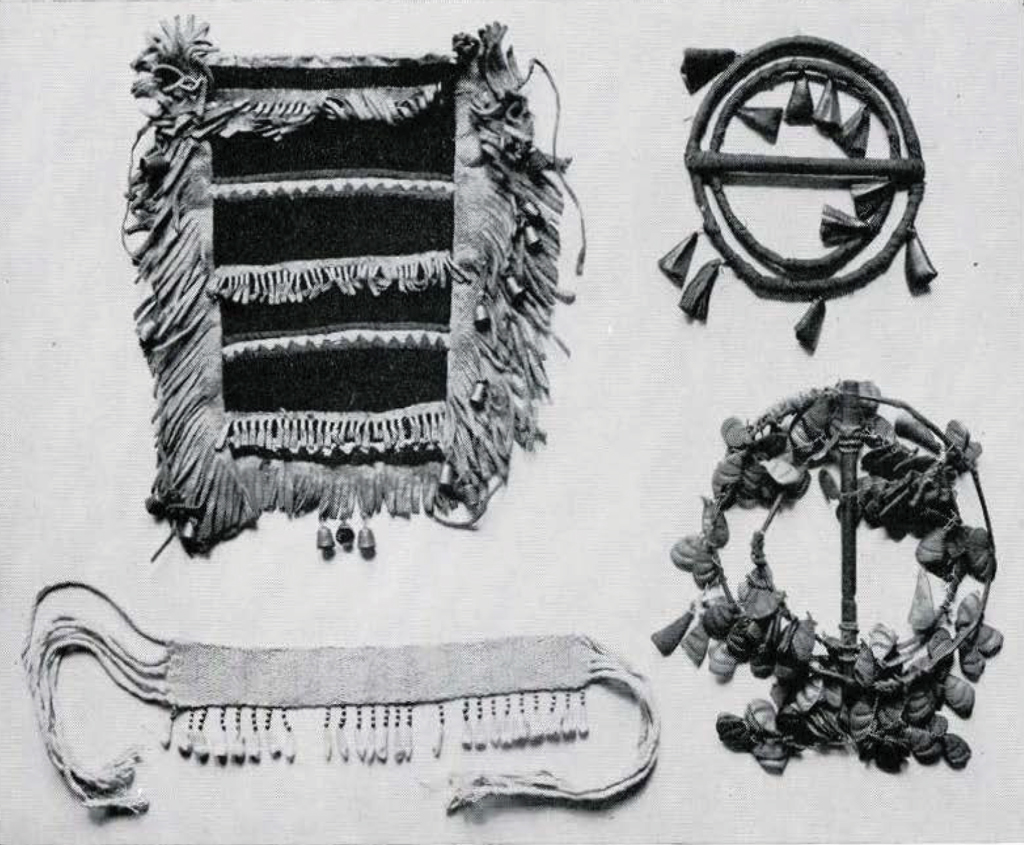
Figure 11a. (lower right) Strung rattle, puffin beaks on concentric rings. Tlingit.
Museum Object Number: NA4977
Figure 11b. (upper rght) Strung rattle. deer hoofs on concentric rings. Northwest Coast Indians.
Museum Object Number: NA1697
Figure 12. (upper left) Strung rattle, metal thimbles on dance legging. Nass Indians.
Museum Object Numbers: NA8519.1 / NA8519.2
Image Number: 46942
TRUE IDIOPHONES
As has been stated before, the true idiophones consist of instruments made of naturally sonorous materials. In America, they consist of four main types: (1) concussion idiophones; (2) percussion idiophones; (3) rattles; and (4) scraping idiophones.
Concussion Idiophones. These arc pairs of sonorous instruments which, when struck together, produce rhythmic sounds.
Concussion Sticks. Basically a pair of similar sticks, these instruments have been widely diffused both in space and time, reaching back to at least 2700 B.C. in ancient Egypt. The bronze concussion sticks from Fara (Fig. 3) are dated c. 2500 B.C. Clappers occur in modern Africa, Asia, the South Pacific, and both Americas. They are mostly used for musical purposes, but in North America they have sometimes adopted other functions. The Shoshone, Shuswap, and Potawatomie use concussion sticks as game calls, the striking together of horns or antlers no doubt considered by deer or mountain sheep as the din resulting from a struggle between bucks over the favors of a doe. The Mono use concussion sticks in a magical connection to equate Thunder.
The usual material for this instrument is wood, sometimes specially designed, as the boomerangs of Australia (Fig. 2), but more often any pieces of wood. Other materials were occasionally used, such as deer antlers by the Potawatomie, or metal, as in the Fara bronze clappers (Figs. 3, 4), the Cameroons sword-knives which are clashed together, and the Philippine iron batons. And the Celebes Islanders strike metal rods together to exorcize evil spirits. Bone was used by the ancient Nahua as the signal for advance in battle and by the Makah in the Elk Dance.
Concussion sticks were used in connection with death in Central Queensland, Australia, where a woman, at the deathbed of her husband, beat two pieces of hard wood together in despair; the Ingalik strike them regularly at funerals and at the end of the ceremony throw them “up river” so that the deceased may have them; and the Omaha funeral song is chanted by young men of the village, who stand before the tent and mark time by striking two short sticks together.
Another parallel between the Old and the New Worlds is the connection of concussion sticks with war dances. On Nauru Island, adjacent to the Gilbert group, there is a dance held before the outbreak of a war or in the pauses between battles. Both men and women participate with the rhythm of the music supplied by foot-stamping and striking long sticks together. At battle, the monarch of the old Nahuans issued his orders to commence the action by sounding on a large shell trumpet; the lords of Tezcuco beat upon a small drum and lords of other provinces struck two bones together. The retreat signals were given upon similar instruments. The California Achomawi held a war dance for about a week before the departure of the war party. Their women stood in a long line, singing and striking two sticks together. When the successful war party returned, the women again sang and beat their sticks.
While the most usual technique is for a single player to beat the two sticks together, occasionally two individuals each hold a single stick and strike them together. In the Gilbert Islands there is a game in which dancing, fencing, and singing are combined. From one to a hundred members of both sexes participate, arranged in sets composed of two couples, which always remain together. Everyone is provided with a light stick, and at a given signal they begin their song and the dancers strike their sticks together, keeping time to the song. This practice is reminiscent of the Cherokee and Choctaw Ball Play Dance where the dancers strike their ball-sticks together while singing.
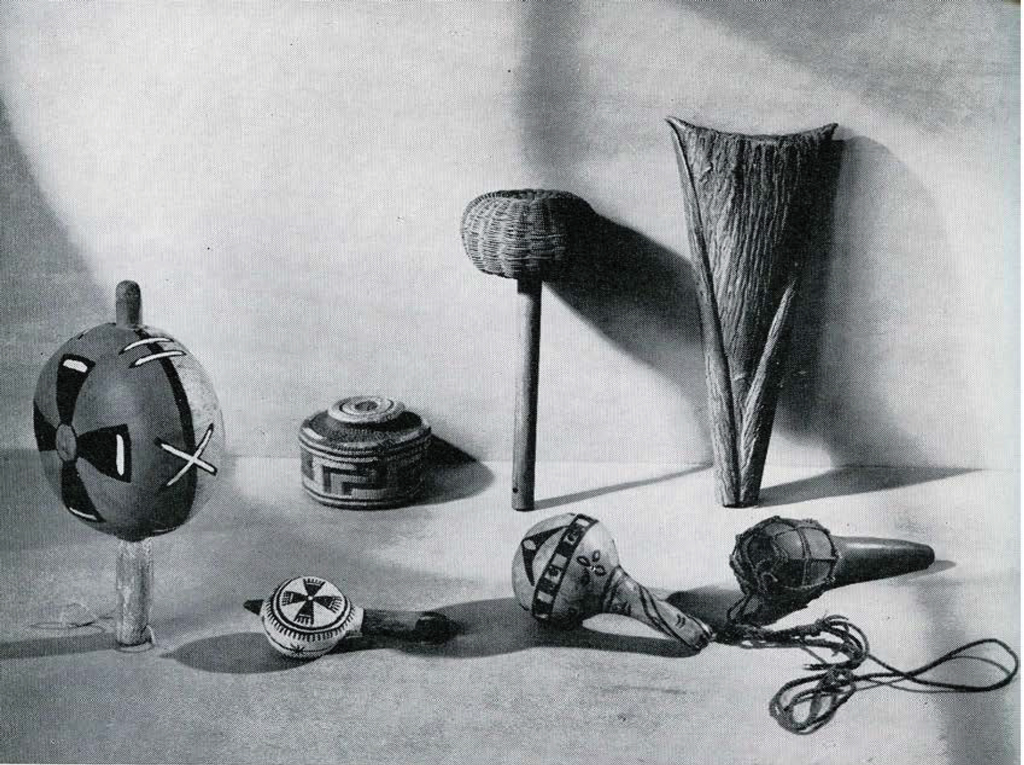
Museum Object Numbers: 42-22-2 / 45-15-1197 / NA1707 / 34270
(Rear) Figure 17. Vessel rattle, basket with rattling lid. Tlingit. Figme 18. Vessel rattle, basketry. Congo. Figure 19. Vessel rattle, bark. Iroquois.
Museum Object Number: NA7693 / AF3637 / NA1712
Image Number: 46943
Concussion Stones. These are variants of concussion sticks, and found in Hawaii and, in America, among the Pueblos and the Nootka. The Hawaiian hula íli-íli (pebble dance) was a performance of classical times, with the dancers holding a couple of pebbles in each hand which they managed to clash together. In America, these stones are used in a non-musical manner, always in a ceremony: sometimes held in the hands, sometimes rolled when the stones are larger. The Acoma have a ritual game in which stone balls are rolled between goal posts (prayer sticks) to make thunder and lightning. In the Zuni Rain Chief ritual, two stone balls are hit together or rolled along in front of the meal altar “to call the thunder.” Such a ball is mentioned at Isleta as belonging to the Town chief, and it was used to send thunder and lightning against the enemy. Santa Clara societies used two stone points to make thunder noise. During the Sea-Otter Dance at the Mooachaht Nootka Winter Ceremony, a dancer clapped two stones together like an otter cracking shell-fish.
One-Hand Clappers. Such instruments differ from concussion sticks only in the method of playing, the former consisting of a pair of instruments held in the same hand, the latter dividing the pair between the two hands. The simplest illustration of the one-hand clapper is the instrument we call “bones,” which is used by most boys and which occupied a prominent place in the minstrel shows of past years. Yet this instrument is a fine example of the “living past,” for it is known from at least 3000 B.C. in ancient Egypt, where prehistoric vases depict female dancers with one-hand clappers. An archaic seal from Ur, elating from about 2800 B.C., shows an animal playing a pair of short one-hand clappers. Leaping over the intervening years to present day Mabuiag, at Torres Straits, one-hand clappers of bamboo about 15 cm. long are used, as well as an occasional pair made of two portions of ribs from the carapace of a turtle. In North America, one-hand clappers were used by the Eskimo, who employed shaved walrus ivory “bones” about 17 cm. long (Fig. 6).
Channel Clapper. This type of clapper consists of a piece of wood split for the greater part of its length so that the two segments slap together to produce a sound when the instrument is shaken or struck against something. A more developed channel clapper has the inside hollowed out so that the two halves have a greater distance to travel, producing a greater volume of sound. The Celebes Island channel dapper, rere, has its two halves separated by a fairly wide space, giving the appearance of a tuning fork. At Mer, in the Torres Straits, reed or small bamboo is split longitudinally, except at one end which serves as a handle; this device is employed non-musically by a rain-maker in imitation of thunder. The Maori have a variant of the channel clapper, constructed of the thick part of a flax leaf, its two halves separated to within a few inches of the butt end, and one half bent abruptly outwards and downwards to weaken its rigidity at the point of bending, thus permitting the end of the leaf to move easily. When held by the unsplit end (the handle) and shaken, the flexible portion of the leaf striking the inflexible part produces a clapping sound.
In America, the California Indians made wide use of the channel clapper, especially in the girls’ puberty ceremonies, while the Indians of the Columbia River and the Basin areas employed them only occasionally. The usual Indian channel clapper was made of wood, either painted or unpainted, with a single split running longitudinally but leaving enough of the wood whole to permit its use as a handle (Fig. 5). North American channel clappers are sometimes made of reed or cane.
The Achomawi and the Shasta held a ceremony before a group hunt in which they struck the channel clapper across their chests; the Bear River Indians, the Huchnom, the Klamath, and the Maidu rapped the split-stick across the palm of their hands; the Maidu also thumped the center pole of the sweat house, while the Wintu knocked it against a piece of wood.
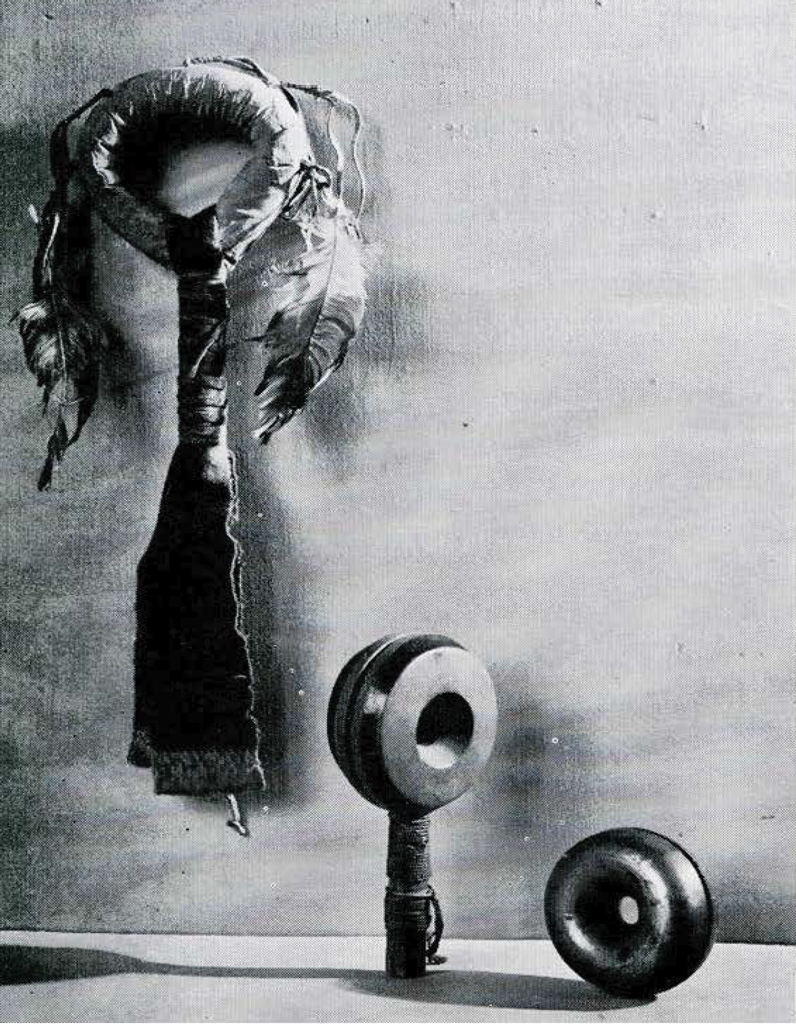
Museum Object Number: NA5442
(Center) Figure 21. Wooden vessel rattle, ring type. Northwest Coast Indians.
Museum Object Number: 40-33-57
(Right) Figure 22. Metal vessel rattle, ring type. Japan.
Museum Object Number: A760
Image Number: 46945
Channel clappers are sometimes used in pairs, as among the Kato, Maidu, Miwok, Patwin, Pomo, and Shasta in their different versions of the Big Head Dance.
Certain extra-musical connotations are implied in the use of the channel clapper. On Torres Straits, it is used to imitate thunder; among the Achomawi, Nisenan, Shasta, and Wintu, it is used in connection with the hunting ceremonies; among the Mattole, Mono, Pomo, and Yokuts, it is used by the shaman in curing; a Miwok Indian had an elderberry channel clapper, which he made himself and which no one could touch, to be rattled before he preached; the Yuki creation myth was emphasized by the use of a channel clapper or by a cocoon rattle.
Hand Clapper. The so-called clapper of the Northwest Coast is related to the channel clapper. This instrument is made of two pieces of sonorous material, usually wood, which are fastened together at one end to form a handle. The upper piece of wood has a flexible shaft which permits it to strike upon the rigid lower piece when the hand clapper is shaken (Fig. 6). The vessel, or striking part, is usually carved and painted with totemic representations.
Deviations from this standardized form are found among the Gabrielino of Southern California, who replace the more usual California channel clapper with two boards that are bound and cemented at one end. The Makah have a hand clapper which is made of a single piece of wood in paddle shape whose blade is thinner than the handle portion. Atop this blade a second piece of wood in the same shape as the blade is attached by heavy cords which pass through openings in both top and bottom, to serve as hinges for the upper part to strike the lower when the instrument is snapped. The Maori channel clapper described above resembles this hand clapper in concept.
Concussion Broom. This is a rhythmic instrument made from a piece of flexible wood or cane whose one end is split into a number of thin segments which can strike together when the broom is shaken or struck against something. In America, California is the center of its distribution and it is used there mostly for girls’ puberty ceremonies, just as is the channel clapper. The concussion broom must be considered as an instrument with an origin and history different from that of the channel clapper. The possible origin of the concussion broom may be sought in techniques like the Australian one in which dancing men smote their left hands at regular intervals with small bundles of grass and flowers held in their right while stamping their feet. The Florida Islanders use bundles of coconut fronds which they beat over a stick during initiation into the Matambala Society. In America, The Mohave Ohwera song series finds the singer striking two bundles of stems together as a musical accompaniment.
These brooms may be sounded by being struck against a portion of the body, such as the hands-by the Australians, or the upper thigh-by the Monumbo of New Guinea, who use small fly whisks while singing. They may be struck against sticks, as on Florida Island, or against a similar instrument, as is the case with the Hawaiian puíli or the Mohave Indian mentioned above. The Yurok strike their concussion brooms against stools.
Concussion brooms occur also in Africa among the Gweabo, in Tibet, Assam, and among foe Dyak of Borneo.
Percussion Idiophones. This is a single sonorous body which produces sound only after being 5\struck with a beater.
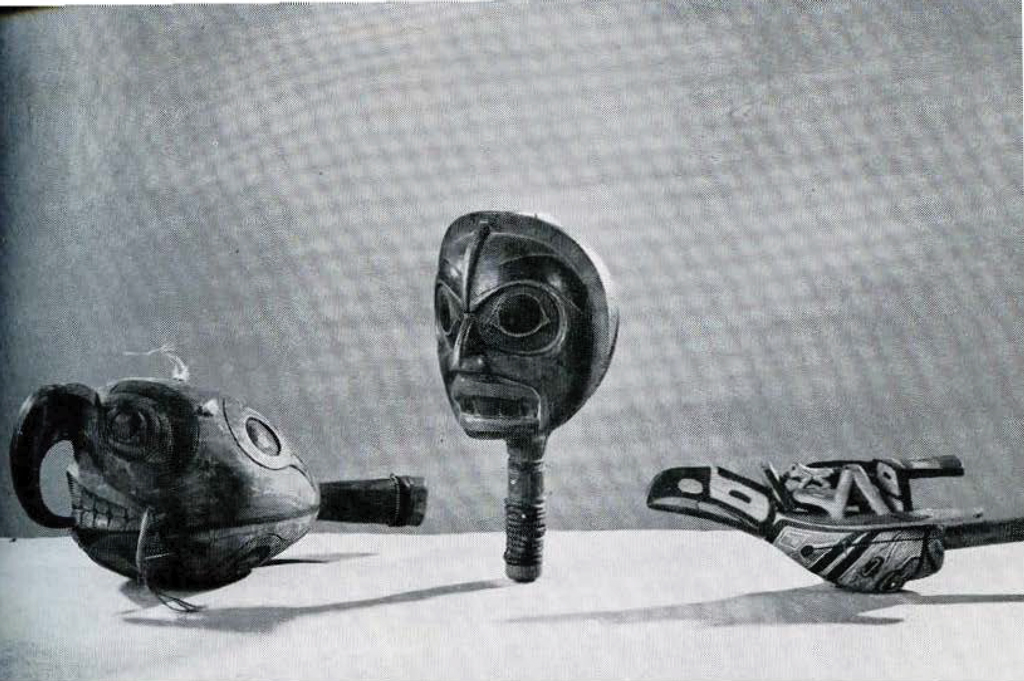
Museum Object Numbers: NA1333 / NA4969 / 12848
Percussion Sticks. These are simply larger pieces of wood struck by smaller ones. This instrument is found in negroid South America, in Madagascar as a part of the Indo-Oceanic heritage of that island, and in the islands of the Pacific to the south and southeast of Asia. In North America, it is limited to the northern California-Oregon seaboard, the Northwest Coast, Mackenzie-Yukon, Eskimo, Basin, and Plains areas.
The most common use of the percussion log (or stick) is as an accompaniment to song, most generally foe songs for the gambling games of the northwest Indians. Among Cowichan puberty customs, the menstruating girl is isolated for four days, during which the women of the village are called in at sunrise and sunset to beat on poles or boards with sticks while they sing certain songs pertaining to this occasion. In Malaya, the Perak Semang accompany their songs by striking short bamboo tubes on a horizontal log, each singer being equipped with two of these strikers.
The next most frequent employment of the percussion log is as an accompaniment to dancing, occurring in the Old World in Madagascar, Pitcairn Island, and Bowditch Island, and in the New World among the Arikara, Bella Coola, Blackfoot, Ikogmiut Eskimo, Mandan, and Shoshone. The least frequent use is as a non-musical agency. The Ba-Ronga of Africa have a version of the drum and bugle corps, composed of ten players on antelope horns, each of these with a different pitch. The individual players are judged and the verdict is announced by a herald with an axe in his hand, who, after his decision, beats the trunk of a tree with the axe, as if to confirm the judgment, and who then runs away to avoid protests and insults from the losers. In a village of the Crees and Assiniboines, prior to a dance, a man rose with a tomahawk in his hand and delivered a long harangue in which he recounted all his exploits, making special mention of two persons whom he had killed and scalped, giving a blow with his tomahawk for each of these against a post which was set up near the center of the tent expressly for that purpose. At a Crow Muddy Hands Society performance, two men dressed in their war suits struck a pole with their coup sticks, the pole representing an enemy. The Paiute thump logs together to attract mountain rams to an ambush or strike a rock with a moccasin to attract the animals. At the Pomo Down Ceremony, the signal to begin the activities or to commence whirling the bull-roarers was given by hitting the center post of the dance house with two sticks.
The usual material for the percussion log, naturally, is wood, although in Madagascar, Tahiti, Banks Island, and Semang, bamboo is used. The Dakota Indians tap upon a sonorous object such as the back of a bow (as do also the Shoshone and Blackfoot), a pipe-stem, a tomahawk blade, or a buffalo rib.
In the Old World two strikers are used more frequently than a single one; the opposite is true of the American Indians. Bamboo strikers are used in Malaya, while roots are the beaters on Banks Island to frighten off evil spirits. In America, the tomahawk is used by the Assiniboine and Cree, arrows are struck against the backs of bows, the coup stick is called into service as a beater, and the cocoon rattle or the fist is struck against a post by the Maidu. Sometimes the Mandan beat a log with deer hoof rattles and the Paiute use a moccasin to strike a rock.
Usually the percussion log is placed in a horizontal position in both the Old and the New Worlds, more frequently elevated from the ground in the former regions. On Pitcairn Island, the head musician of a dance group had a piece of musical wood balanced nicely upon his toes so that it might vibrate more freely. The African Pahouins fit the ends of their long horizontal beam into two posts thrust into the ground. In America, portable percussion sticks are found. The Bella Coola Kusiut Ceremony has one of its principals carrying a small baton in his right hand which he strikes against a larger stick carried in his left. The Blackfoot Tea Dance finds the dancers beating time on a dipper of tea while performing, and the Piegan Blackfoot Pigeon Society dancers strike the bow with an arrow. The Shoshone use of arrows to strike a bow has been described.
When the percussion log is in a vertical position, it is usually found to be a post serving a structural function in a tent or wooden building. Exceptions to this rule are the striking of a tree with an axe by the Ba-Ronga, and the Assiniboine-Cree and the Crow posts which are expressly set for the purpose.
In both the Old and the New Worlds, males usually beat percussion logs to prove Curt Sachs’ theory of the percussion idiophones being phallic symbols. A further corroboration of Sachs’ theory is afforded by the Sanpoil-Nespelem. In the men’s gambling game, beating of logs accompanied the play. But when women played the same game, singing was the only audible accompaniment, the women swinging their arms in opposite directions instead of beating on a log. However, examples of females wielding the beating stick are found in South Celebes, where a three-meter long wooden beam, hanging on fibre cords, is struck by women and girls at night. At Semang, a bamboo tube is likewise struck by women. In America, Cowichan women strike the walls and poles of the puberty house, while Twana women accompany their singing by pounding small sticks on larger ones or on boards in front of them.
Parallel uses of the percussion log in connection with magic may also be found. As mentioned above, Banks Island priests strike their bamboo tubes with two roots to frighten off the spirits. In curing, the Sanpoil-Nespelem shaman sings his doctoring songs with his audience joining in the singing and beating time on the floor or on a plank held vertically. In addition, seated persons sometimes beat on a log with short sticks. The shamans at Shoalwater Bay, where dwells a Salish group, called in singers who sat beside two long poles which lay on the ground, one on each side of the room, beating on them with sticks while they sang. Twana medicine-men are likewise accompanied by their audience striking logs. Wishram shamans sing to their patients while their assistants beat upon poles with two sticks.
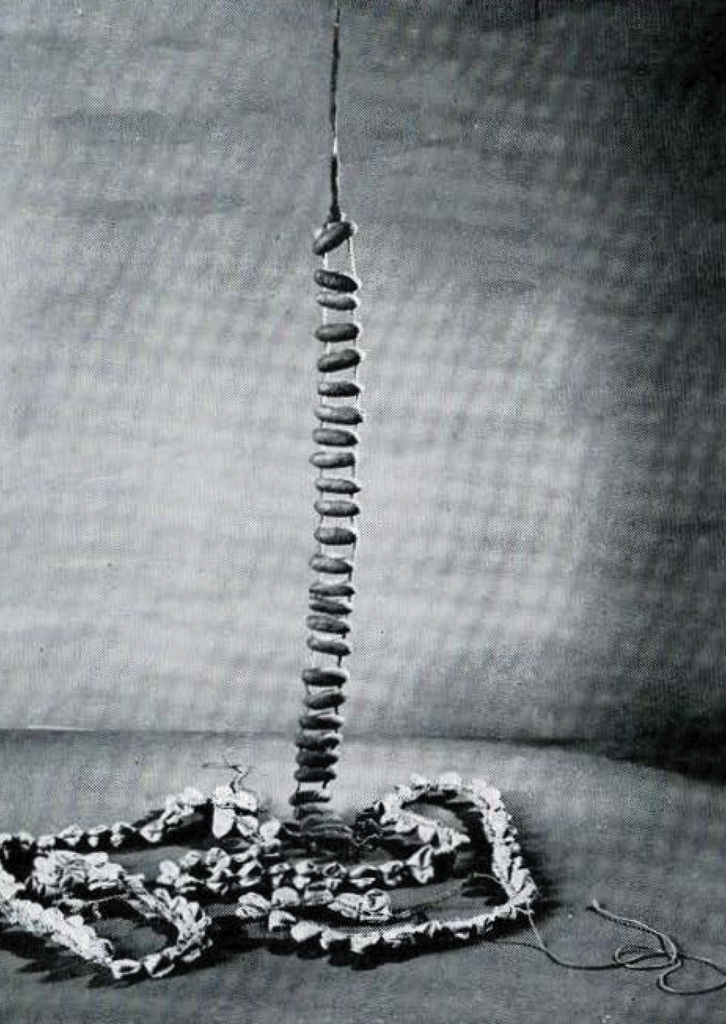
Museum Object Number: 31-2-196A / 31-2-196B
Figure 25. (recumbent) Vessel rattle with cocoons. Pima.
Museum Object Numbers: 45-15-1203A / 45-15-1203B
Image Number: 46947
Percussion Plates. Differing from the percussion log in both form and use, the percussion plate is found in both the Old and the New Worlds. It has length and breadth but little thickness, whereas the percussion log may have the same dimensions for both width and thickness. The percussion plate may be struck with a beater or it may be stamped upon, in which case it is called a foot-drum. Possibly, portions of buildings served as the first percussion plates, since they were already at hand and required no advance preparation. The floor served admirably, giving rhythmic sound as a result of the foot-stamping of the dancer, thus being a natural outgrowth of the prototypical idiophones. In Celebes and at Ceram, heavy floor planks of the temple were not properly fastened to the building foundation so that they could spring and make a terrible noise when the dancers performed on them. In Hawaii, also, the floor was stamped. In America, stamping on the floor appears to be localized among the California Indians, while striking the floor with sticks is found along the Northwest Coast, with occasional occurrences among the Chnagmiut Eskimo, the Sanpoil-Nespelem, the Shasta, and the Thompson Indians. The Yurok have a refinement of this type of stamping in that the drum-orchestra, which is composed of several men, sits on stools or on wooden pillows to drum with the feet while in this position. Striking the wall or the roof is confined to the Northwest Coast Indians.
Where beaters are used, either one or two might be employed. The percussion plate is sometimes so small that a single player strikes it, while at other times long boards are beaten by an ensemble of drummers. The striker is usually of wood, most frequently plain, but sometimes, especially along the Northwest Coast, carved with totemic designs and thus definitely planned for the occasion. Materials other than wood are sometimes employed as beaters. The African Thonga strike their spears against their shields; the Bella Coola use horn spoons against the sides of their canoes and, in a myth, they strike the floor with a stick decorated with copper jinglers or with the leg bone of the mountain-goat. Tlingit shamans, in practicing about the sick, have been known to use a bone beating stick, carved to represent a land-otter’s head. In California, lobster claws are fastened to sticks which are then struck against boards. In the Chinook Spirit Dance, “power sticks,” which are long poles to be struck against the roof, have deer dew claws attached as rattles which emit their sound with the shock of the poles against the roof. The Kwakiutl beat walls with their fists, boards with stones to accompany mourning songs, or canoe thwarts with paddles. The Quileute Wolf Ritual finds members of the Wolf Society walking around a house, shouting, pounding the walls with sticks, and throwing rocks at them. Shasta Big Head Cult members keep time while dancing by striking the butt end of their cocoon rattles against their foot-drum.
Percussion plates are usually employed as musical accompaniments for dancing or singing, sometimes in special connection with shamanistic practice, puberty ceremonies, war events, death, or gambling songs. Their use in a non-musical sense is also found. The Ba-Ronga strike a shield to attract attention and the Thonga do likewise as a response to the words of a song. The northeastern Malecite-Micmac Indians call forth the souls of the dead by striking on the bark of their wigwams. The Bear River Indians of California, when in danger of capsizing a canoe, slap the side of the boat, addressing the name of a mythical boat which had the power to prevent them from upsetting. A Chnagmiut Eskimo, during the Great Festival to the Dead, thumped the floor with a pole seven or eight feet long to arouse the shades and call them to the dance. The Hopi tap boards, roofs, and floors to signal the arrival of some of their ceremonial personages. The Yurok and the Nootka strike percussion plates to frighten away eclipses.
In both America and elsewhere, percussion plates are beaten more frequently by males than by females. In America, the instrument is connected very frequently with either religious ceremonials, puberty rites, or shamanistic practice, a fact which does not accord with its employment in the Old World, where it is usually used as a mere musical accompaniment. Regardless of its function, the playing position is almost universally horizontal, either slightly elevated or else flat on the ground, except when the plate is small enough to be carried in one hand while beaten by the other. Exceptions to this rule are found among the Kobuk River Eskimo, who take a dead spruce log, split it in two, and hollow out one of the pieces about three feet long. This is hung horizontally from the roof so that the convex and concave sides face laterally, the convex side being struck by the player. This is not too different from the large percussion plate carved in the shape of a fish which the Chinese and Japanese hang from the caves or a frame in front of their Buddhist temples to be struck as an assembly signal (Fig. 7). Another exception is found with the Wishram spirit dance songs, which were accompanied by a percussion plate made of a plank set upright in the earthen floor of a house, the board struck by a horizontal pole slung from the rafters by a rope at each end. A man could easily swing this so that the board was struck by an end-on impact. In both China and Japan, large bells are sounded by horizontal poles mounted in just the same way.
The usual material for a percussion plate is wood which might be utilitarian in its original purpose. Any wooden floor, wall, or roof might serve, as well as the sides of canoes, canoe paddles, or stool seats. In Australia, wooden spear throwers are struck. Bark is used by the Indians in the northeastern region and by the Maidu in the west.
This instrument is encountered in the Pacific Islands, Australia, New Zealand, Africa, and the Andaman Islands. In North America it is used along the entire western seaboard from mid-California to British Columbia, in the Mackenzie-Yukon region, and by the Pueblo tribes and the northeastern Algonkins.
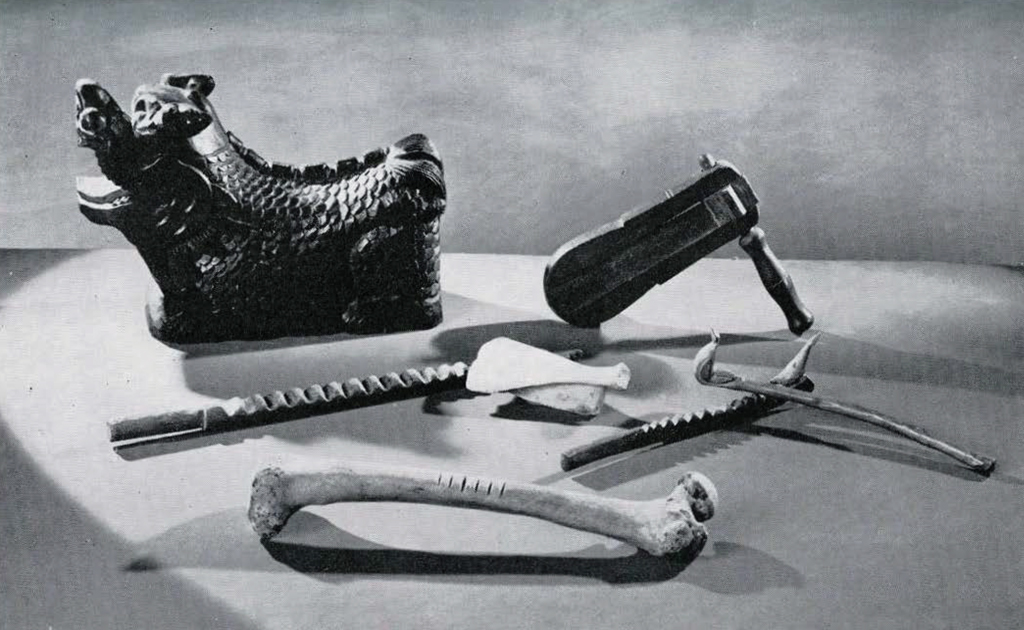
(Center) Figure 27. Scraping stick with scapula scraper. Hopi. Figure 28. Scraping
stick with wooden scraper. Apache.
Museum Object Numbers: 38634A / 38634B / 45-15-1204A / 45-15-1204B
(Rear) Figure 29. Scraping vessel from Korea. Courtesy of Schuyler Camman. Figure 30. European ratchet.
Image Number: 46948
Percussion Vessel. Any vessel, beaten by the hands, the feet, or a stick, is a percussion vessel. Metal ones are especially popular. Five-gallon oil tins are used by the Ba-Ronga, whose women and children beat them in concert with other musical instruments to frighten away birds that gorge themselves on sorghum and millet seeds. The Hopi Agave watchmen’s patrols ring clapper bells and strike empty coal oil cans with sticks to warn the women and the uninitiated away from the ceremony, lest snow should not come. The St. Lawrence Eskimo have a dance orchestra consisting of seven men, one provided with a handle-drum, five with empty five-gallon kerosene cans which they beat with heavy sticks, and one with two blocks of wood which are struck together.
Other household implements of metal are also used. A dance orchestra on Pitcairn Island with three players has one using a percussion log, one a gourd percussion vessel beaten with two hands, and the third an old copper fish-kettle which fanned a sort of bass. On Bowditch Island, a priest beat an old tea-kettle, which was tabooed and held sacred, with an iron knife. The final exhibition of the great Thunderbird Ceremony of the Makah employs a whole ensemble of percussion instruments, with beating drums, roof and wall pounding, shell rattling, and the striking of drums improvised from the brass and sheet-iron kettles and tin pans belonging to the domestic furniture of the house; the idea is apparently to create as much noise as possible. The Wampanoag of Rhode Island made music by knocking on a kettle. The Kwakiutl of Quatsino Sound have a ghost dance in conjunction with their Winter Ceremony at which they beat the bottom of a pan inverted on the surface of water, an idea related to the water drum, which will be discussed later. The concept of the floating percussion vessel is also known in Mexico, where the Yaqui, in common with southern Mexican tribes, use a half-gourd, floating in a large olla of water and drummed with a stick; the Nevorne of the Rio de Sonora have a percussion vessel consisting of a “corita” or impermeable basket filled with water on which an earthen bowl is placed upside down and struck with a stick. The Haussa of Africa fill large water basins and then place half-gourd shells on the surface of the water, the gourds being struck with a pair of forked sticks. The same takes place in Tripoli at weddings.
However, the most common material is wood, usually in the form of an upturned bowl whose inverted bottom is usually struck by sticks, as in Hawaii and by the Clallam Indians, or else by the hands as in Australia. The wooden vessel might be made in the form of a large box with an open top, which is usually struck by the fist with shredded cedar bark wrapped around as occurs in the whole Northwest Coast area of North America, or else struck with a hammer as in China and Japan. The Chinese and Japanese make a wooden percussion vessel with a slit cut into the bottom, the vessel being in the form of a conventional fish (Fig. 9). At Fraser River, British Columbia, a similar vessel, in the form of a frog, was excavated (Fig. 8). The inhabitants of Belitoeng Island in the Dutch East Indies strike a wooden cask with a wooden stick.
The use of a gourd as a percussion vessel is also known. The African Loango use a bottle-gourd which they strike alternately on the thigh and with the hand; the Pitcairn Island usage has been mentioned; in Hawaii, two gourds were neatly joined together, placed upon a cushion, and beaten by the hand at the aperture of the gourd; on Easter Island, a large gourd was placed in a deep pit where it was danced upon by a man; the Houma, a tribe of the southeastern United States, used a gourd drum.
Among other materials used as percussion vessels only in North America we find the floating pottery of the Nevome (see above), hollow stones beaten by the Hopi with two little sticks, and basketry drums in California and the Southwest. Turtle-shell drums were struck by the Aztecs, and at Iztlan and Tajin in Mexico, as well as by the Diegueño, Mohawk, and Onondaga. A whole nautilus shell is struck with a stick at Blanche Bay, Matupi Island in the South Pacific, a practice unduplicated in America.
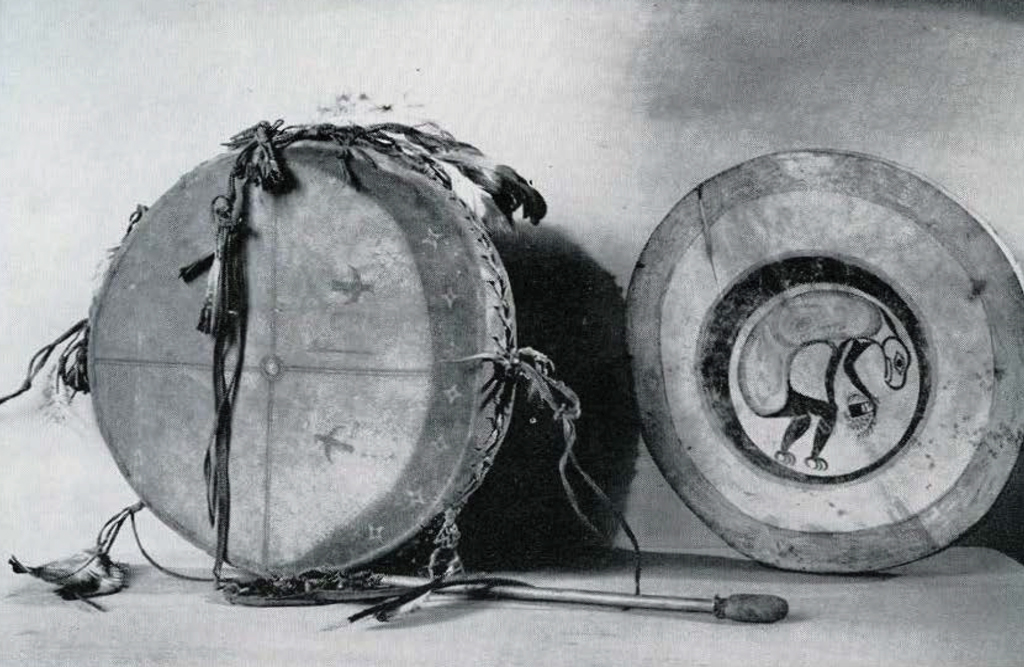
Museum Object Number: NA5218
Figure 32. Frame drum with single head. Nootka.
Museum Object Number: NA1687A / NA1687B
Image Number: 46949
The striking is about evenly divided between the use of the hands or sticks. The wooden box drum is almost always beaten by the fist, the basket drum usually by a stick. Sometimes the simple stick is embellished, or else another material is substituted for it; the Bowditch Islanders use an iron knife; hoof rattles were attached to sticks by the Chetco, Navaho, and Tolowa for striking the basket drum. The Navaho also have a special stick used only with the Night Dance. This beater is made from the leaves of the yucca baccata, folded and wrapped with split leaves, which are gathered with much ceremony regarding the points of the compass, and inside of which are grains of corn. The drumstick is buried in moist earth each clay until it is needed for the Night Ceremonies; this keeps it from becoming dry and shriveled. A fresh one is made for each ceremony, after which it is destroyed and the fragments deposited with prayer and pomp in the fork of a cedar tree or some other secure place; in this way the soul of the drumstick is released and its substance sacrificed to the gods. Rarely, the foot is used as a striker, as on Easter Island and by the Makah Indians, who, according to one informant, usually had two box drums in a house, one at each end; three men sat on top of each and kicked it with their heels or struck it with sticks or their fists. The older Quileute Initiation Ceremony box drums were struck by the hands and feet of the drummer. The Achomawi used a pack strap as a beater when they struck their basket drum to frighten away a bear, while the Llanero Apache beat their basket chum with a girl’s moccasin at their puberty ceremony.
Percussion vessels were sometimes at the service of the shaman. The Ba-Ronga songs of exorcism were performed with an accompaniment of rattles, big tins, and drums, close to the ear of the patient, to induce the spirit to reveal its name and to “come out.” The Onondaga and Mohawk sorcerers used tortoise-shell drums in curing. The Clallam medicine man strikes his wooden bowl and drum while singing, and the Kwakiutl shaman uses his box drum as a part of the Great Ceremonies. The Nootka Shaman’s Dance also employs the wooden box drum as one of the chief instruments.
Percussion vessels were used in non-musical function among the Wong-kanguru tribe of Australia, where the pirha, or wooden bowl, was struck several times to keep the women informed as to the beginning of the ceremony. The Achomawi drummed on their basket drums with a pack strap to frighten away bears. The Hopi striking of kerosene tins as a warning has been described. The Quileute have a tradition of the Battle of Ahkalot (James Island, now known as Lapush), where the big drum called every Quileute brave from throwing rocks on the dead enemy to the fighting line.
Rattles. These are instruments which, by shaking, produce rhythmical sound through the concussion of sonorous materials. In this survey, two distinct types will be mentioned: the strung rattle, with the rattling agents suspended from an object such as a stick, a piece of clothing, or a cord; and the vessel rattle, with rattling agents enclosed in a cavity so that they strike against each other as well as against the side of the enclosing vessel.
Strung Rattles. Found practically everywhere in the world, strung rattles are made of a well-nigh inexhaustible variety of materials: beads, bird beaks, small bones, hoofs, sheep scapulae, claws, shells, seeds or nuts, wood pieces, teeth, and metal. In many cases it is difficult to determine if a sonorous object on clothing or a necklace is used merely for ornamentation or if it is intended as a rattle. The safest criterion is to judge if the apparent rattle is used only as equipment for the dance, in which case it must be included among the rattles. Items of this type include dresses, skirts or aprons with any of the above-listed materials attached; belts, necklaces, bracelets, anklets, and head-dresses also fall into the same category if they are employed essentially for their sound in the dance, when the movements of the dancer cause the rattling agents to be agitated and to be struck against one another. Originally the materials used had magical symbolism, as for example among the Mundurucu Indians of Brazil, who use the teeth of a dead enemy to derive strength from the slain one (Fig. 10).
Limitations of space do not permit going into great detail about this extremely varied element, but three most interesting parallels must be noted. The Northwest Coast Indians have an old type strung rattle, originally of the beaks of the sea-puffin, but more recently of deer hoofs, mounted by sinew cords to a withe in circular shape. This withe may be one of two or three, arranged in concentric circles, the entire piece held together by one or two crossbars; or it may exist alone with a single cross piece (Figs. lla, b). On Torres Straits, there is also a rattle made of the stem of a plant tied into a circle with two cross pieces across the center as a hand-hold. To this circle Barbatia shells or gòa nuts are tied in a manner very similar to that of the Northwest Coast rattles.
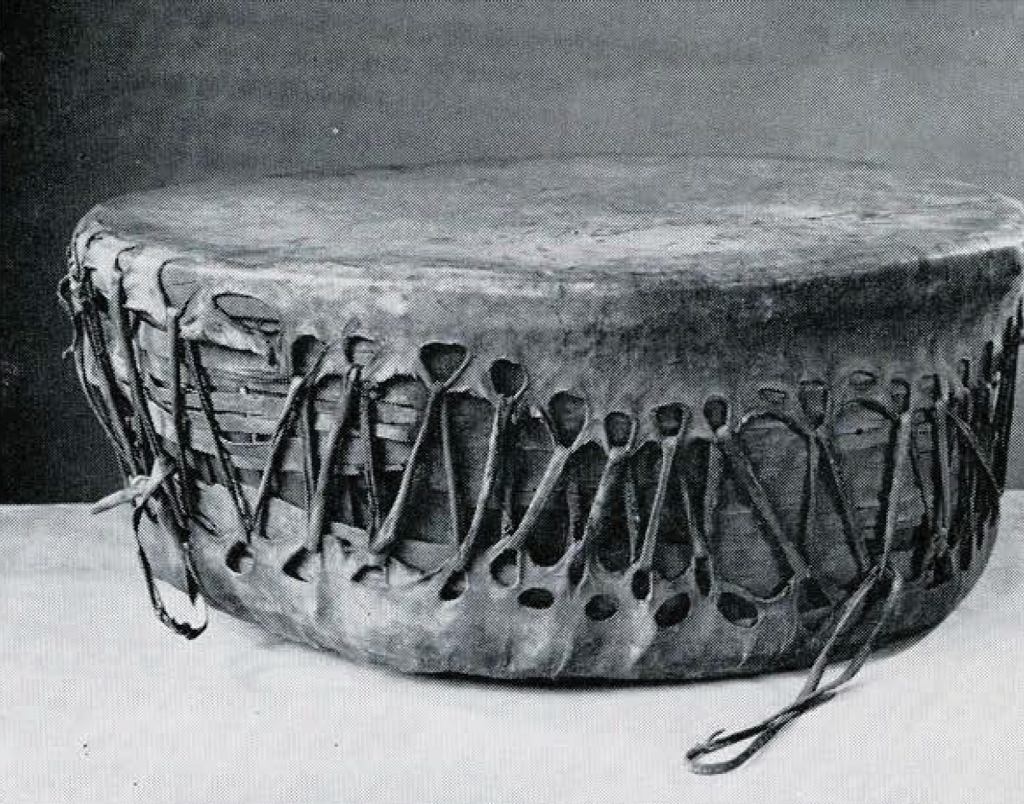
Museum Object Number: 36901
Image Number: 46950
The second of these parallels is the use of the strung rattle as a game decoy or an alarm to notify a hunter or fisherman of the presence of his prey. Malayan and Melanesian fishermen arrange half-coconut shells on a frame which is attached as a Jure to their shark nets. The Ambryn of New Guinea use halves of nut shells. In North America, the Hare Indians decoy caribou by tying bunches of caribou hoofs to their belts which, when shaken, attract the curious beast to the reach of the hunter. The Tahltan and Takutine fasten to their beaver net a rattle of caribou or moose hoofs which sounds as a notification for the hunter as soon as the net is shaken, even so slightly. The Carrier beaver net now uses several small bells in place of the beaver claws and pebbles of yore. In California, the Mattole, Sanetch, Tolowa, Wiyot, and Yurok set crab claws as rattles in their fishing nets.
The third parallel is found between the Yakuts and Yukaghir of Siberia and the Northwest Coast people. Both Yakuts and Yukaghir shamans wear special coats whose backs are ornamented with conical metal pendants. In America, ceremonial dance aprons or leggings have conical metal jinglers attached, the later ones with metal thimbles, although the older ones had puffin beaks or deer hoofs as the rattling agents (Fig. 12).
Vessel Rattles. These are found in almost as great variety as the series rattles. Materials found in both the Old and the New Worlds include rattles made of bark, basketry, gourd, metal, pottery, sacks, seeds, shells, wood, and cocoons. Once again, limitation of space prevents a thorough examination of all the vessel rattle types. They occur in one material or another in great profusion everywhere except in Asia, where they are quite exceptional.
The origin of the vessel rattle is to be sought in nature itself; in the shaking of a whole gourd, usually of the Lagenaria species, whose dried seeds strike against the sides of the vessel. Rattles of this type are found in Peru (Fig. 16) dating from pre-Columbian times. In North America, the Catawba, Pamunkey, and Rappahannock Indians of the Southeast still use the entire gourd with its seeds dried inside, revealing remarkable persistence, since the complete loss of the native religious ceremonial heritage for more than a hundred and fifty years has resulted in its disappearance among the other tribes of the area.
The more usual practice is to insert a wooden handle into the gourd after rattling agents have been placed inside the vessel. These agents may be corn kernels, pebbles, seeds, glass, or metal. It is interesting to note the transition from gourd to pottery that takes place in the Pueblo area, where the natural form of the gourd has been taken over by later pottery (Figs. 13, 14, 15).
Interesting parallels are to be found in the use of bark as an enclosing vessel: Sir Francis Drake describes rattles of Patagonia as “being made of barkes of trees, and sewed together with thredds of gutts of ostriges, like lute strings, and little stones put in them and painted over, . . . they hang by strings at their girdles, when they are disposed to sport themselves; which no sooner begin to make a noise but they beginn to dance. . . .” (Voyages of Sir Francis Drake around the World, Hakluyt Society, 1854, p. 50). In North America, bark rattles of two types occur. The first is merely a cylinder of bark with pebbles inside, mounted on a stick handle. This type is found among the Chippewa, the River Desert Indians (an Algonkin group), the Saulteaux, and the Tete de Boule. The second type of bark rattle consists of a heavy piece of hemlock bark which is bent into a triangular shape with an inserted stick that serves both as a plug to keep the pebbles inside the vessel and as a handle to reinforce the bark (Fig. 19). These triangular rattles are peculiar to the Iroquois Confederacy.
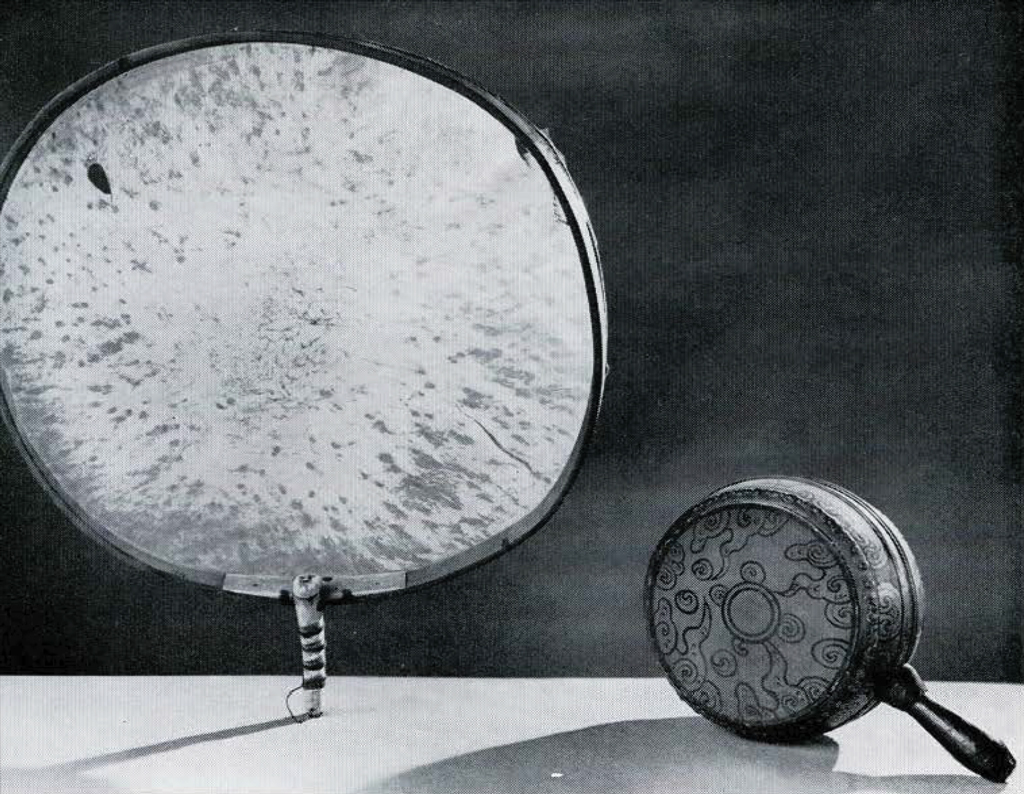
Museum Object Number: NA1220
Figure 35. Handle drum with two heads. Mongolia.
Museum Object Number: A847
Image Number: 46951
Rattles made of basketry are found in Ancient Egypt, Africa (Fig. 18), Timor, New Guinea, Ancient Peru, and the two Americas. In northwest Africa, the basketry rattle is preserved as a cult implement, treated with awe. As a relic from cult days, Besone children of the Congo are not allowed to shake the basketry rattle during the period of the New Moon. In most places, this rattle is considered as a child’s toy, as by the California tribes. The Tlingit and Kuskogmiut Eskimo make them in ball-form; the Mohegan have a five-sided rattle which, with its handle, is made entirely of basketry. The Northwest Coast Indians again reveal their individuality with the Kwakiutl use of large cylinders of basketry partially filled with stones which crash together when the cylinder is tipped from end to end; the Tlingit manufacture pretty baskets of different sizes whose lids contain a space into which rattling agents are placed so that they rattle when the lid is shaken or tilted (Fig. 17).
Vessel rattles are sometimes made in a ring or loop form. In South and East Asia, these rattles are made of two metal halves which have small pellets enclosed by tying the halves together (Fig. 22). They are usually used as armor leg-rings in these regions. In China, ambulant doctors use them as aids in their medical arts. North America also has rattles in ring form, but almost always with a handle. In the Plains area they are made of rawhide (Fig. 20), while on the Northwest Coast they are made of wood consisting of two halves joined together just as they are in Asia (Fig. 21). The American rattles are used in society ceremonies and in the majority of cases represent the sun or the stars.
The gourd rattle with a wooden handle, so well-known and so widely distributed in Africa and the temperate and tropical zones of both Americas, cannot be discussed here.
Wooden vessel rattles are found mostly on the Northwest Coast of America, where they occur in a profusion of forms, elaborately carved and painted (Figs. 23a, b, c). The Ba-mbala of Africa carve a wooden rattle in the shape of a hawk-bell, place a loose stone inside as a rattling agent, and hang it between the hind legs of a dog when driving partridge.
Vessel rattles made of cocoons with stones inserted as rattling agents are found in Africa (Fig. 24) and North America. The Ba-Ronga have an ornament for dancing or for use at war made of silvery cocoons of the Queen Moth found on nkanye trees; the chrysalis is removed and each cocoon is filled with grains of millet which rattle in dancing. In northwest Africa, rattling cocoons are tied to a net as external strikers of a gourd rattle. In north-western Mexico and the region affected by the California Indians, the cocoon rattle is much used, appearing in three forms: (l) a stick with from two to ten cocoons tied to one end; (2) dance leggings with rows of cocoons attached; (3) long strings of cocoons wrapped around the legs. The first type is by far the most common, being used for shamanistic curing, as the favored instrument at the girls’ puberty celebrations, in ceremonies, as accompaniment to song and dance, or as a toy. The cocoon rattle on a stick was limited to the California sphere. The Papago use the legging type in which the older cocoon is occasionally replaced by modern small paper bags of approximately the same size as cocoons, the paper being filled with pebbles. The concept of dance leggings, while widespread in North America, is especially striking when one compares those of the Papago with those of the Northwest Coast people, the chief difference being in the use of cocoons or paper bags among the former, and puffin beaks, deer hoofs, or metal among the latter. The third type, employed by the Pima and the Yaqui, consists of up to a hundred pairs of cocoons on long leather or buckskin thongs (Fig. 25).
Scrapers. These are instruments with notches (cut along one or more surfaces) that are rubbed with a rigid object. The scraped object may be held in the hand, rested upon the knees or upon the ground, or placed upon a resonator. The sound that results from the scraping operation is unpleasant, suitable only for rhythmic purposes. Two of the four types of scrapers interest us here: scraping sticks and ratchets.
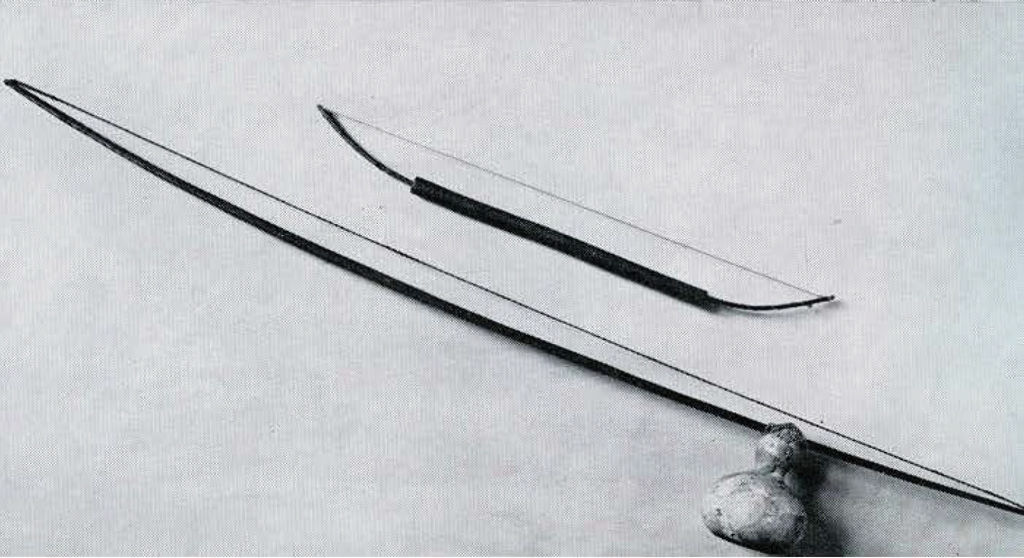
Museum Object Number: AF267
Figure 37. (smaller) Musical bow without resonator. Kafir, South Africa.
Museum Object Number: AF266
Scraping Stick. This is manufactured from a variety of materials, such as wood, deer antlers, human femurs, or animal bones. The Aztecs scraped either deer antlers or human femurs in their sacrificial ceremonies (Fig. 26), a practice duplicated in part by the Cheyenne Kit Fox Society, who scraped notched elk antlers representing a snake to be used as game charms, and by the Arikara medicine societies in their Buffalo-Calling Ceremony, in which they scraped a notched human forearm bone. Animal and bird bones were notched as scraping sticks by the Apache and Basket Makers, who used buffalo ribs and deer ribs respectively; the Huichol of Mexico used deer bone and the Indians of Tierra del Fuego, bird-bone, as is revealed by an archaeological specimen in the American Museum of Natural History. Wood, naturally, is the commonest substance used for the stick form, the wood sometimes ornamentally carved to represent some animal or bird (Fig. 28). The scraping stick was an extremely important ceremonial object among the Pueblo Indians.
Resonators are used by the African Washambala, who employ a board for the purpose. The Chinese yü (Fig. 29) is usually a crouching tiger along whose back there are twenty-eight grooves to be scraped by a split bamboo stick; here the body of the tiger serves as resonator. The Javanese slentem (so called in Mahillon’s catalogue) must be included among the scraping vessels, as it is a carved wooden bird on the line of whose back there is a bronze plate with shallow grooves that are rubbed with the bronze plectrum, tabuh. In North America, the resonator is usually a basket in the Southwest and California, a tub in the Plains area, and a gourd, pumpkin, or box among the Pueblos.
The object which is drawn against the notched portion of the instrument is made of a number of different substances, ranging from the Aztec snail shells and the scapulae of hoofed mammals used by the Pueblo, Pima, and Huichol Indians (Fig. 27), through the bronze plectrum of the Javanese slentem, to the more usual wooden stick found almost universally.
A variant of the scraping stick is used by the Paviotso and Paiute Indians. This consists of a grass-filled hide which is wrapped with a rope and then rubbed with a stick.
Ratchet. The ratchet, the least frequently used of the scraper types, consists of a toothed wheel or notched cylinder mounted on a handle which extends through a frame. At one end of the frame, a thin, flexible wooden blade is attached in such a way as to reach the toothed wheel, against which it scrapes when the instrument is twisted around. The ratchet represents a form between the true scrapers and the plucked idiophones, such as the jaw harp. It is used mostly as a toy or simple noisemaker. Ratchets occur in Java, India, Mesopotamia, and Europe (Fig. 30). In North America, the Ingalik made cedar wood ratchets for boys’ toys. However, the Ingalik usage shows certain characteristics which suggest that the instrument was not always a toy, since it was used at particular times (mostly in summer and only in the daylight) with an inherent magical meaning, as its sound attracted evil spirits. The Ingalik informant insisted that the ratchet was an aboriginal element, which appears to be corroborated by the apparently symbolic meanings of the instrument.
Interesting non-musical facts are connected with the scrapers. The bamboo scraping tube of Torres Straits, which is rubbed by a clam shell at night during the turtle season, is a clear case of a hunting charm. In North America, scraping loses its magical meaning and becomes a mere hunting decoy. The Eskimos scrape the surface of the ice with a small implement shaped like a hand, on the end of which two or three projections hold bear claws. The Indians of the Mackenzie-Yukon district scrape bushes or trees with antlers or two sticks together as a decoy for moose and deer.
Interesting also is the close parallel between Torres Straits and the Havasupai. In the former locality, the bamboo scraper (kat or katak, ”green frog”) receives its name because of the sound it makes. On the other hand, the Havasupai associate the rasping sound with the frog and the production of rain.
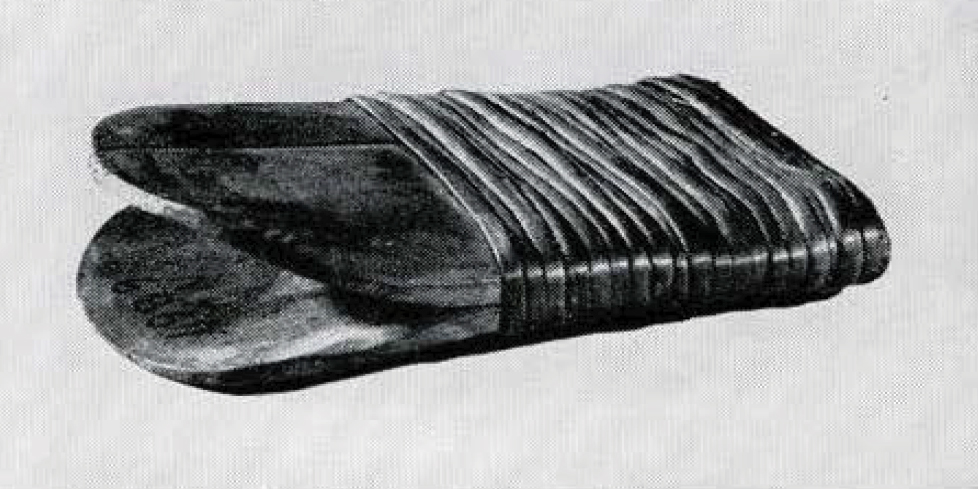
MEMBRANOPHONES
A membranophone consists of a vessel covered by membrane which vibrates when struck to cause a sound that is usually without pitch.
Kettle Drums. Made of a natural fruit shell covered by a membrane, kettle drums occur in Hawaii and among the southeastern Indians. The Hawaiian drum (pu-niu), used in the hula pahu, is made of coconut shell whose top portion is removed, the opening covered by a scaleless fish skin. When the pu-niu is used it is strapped on the right thigh of the performer, who strikes it with a braided fibre held in his right hand, his left hand being free to manipulate a large cylinder drum that stands on the other side. The Houma and the Meherrin Indians used a drum made of gourd with a skin stretched across its mouth.
Water Drums. A curious feature of both North and South American kettle drums, as well as of some of the cylindrical ones, is their being partially filled with water during their playing. It is not clear exactly why this practice was adopted, as certain of the tribes claim there is symbolic power in the action, while others do so merely to tune the drum or to improve its sound. In both Americas, water drums of wood and pottery, covered with a single head, arc found. In most cases they are connected with a ceremony, suggesting a symbolic meaning to the practice. A large segment of North America uses metal for these drums, especially in connection with the modern peyote ceremony which has extended to many of the present-day tribes.
Unusual water drums are made of cypress knees by the Creek, Shawnee, and Tunica, while the Kwakiutl have what might be a prototype in their Winter Dance ceremonies; the night preceding the beginning of the ceremonies a frame drum is placed in the river so that the wooden frame is under the water while the skin is held just above the surface. The beating of this drum produces a very loud sound.
Frame Drum with Single Head. This type is constructed by bending a narrow piece of wood into a hoop, fastening the ends of the hoop together, and covering the open area with a single membrane. Found almost everywhere in Morth America, it is lacking in the Southeast; in the Northeast it seems to be post-European; in most of California, it is a recent element. Abroad, these drums are found among the Lapps, the Thonga-Zulu, in India, Japan, and Siberia.
The Lapp drums, those of the Altai and Ostyak in Siberia, and the North American examples are sometimes decorated on the membrane surface with what had originally been symbolic figures (Fig. 32). This symbolism has been lost as the drum became the property of the secular members of the North American tribes, among whom the painting is now merely a decorative adjunct. The earlier, although by no means extinct, function of these drums was to aid the shaman in his curing; its voice called the benign spirits and banished the hostile ones; its symbolism gave support to his mystic powers. The power of the drum lies chiefly in the sounds emitted by it. While the skill of the player can bring out musical effects which enhance the emotion of the moment, the sound, per se, is considered as something living, capable of influencing the invisible spirits. The Yukaghir of Siberia call the drumstick “the tongue of the drum.”
Where most American drums of this type are round, the Siberian and Lapp examples are more commonly egg-shaped. Rectangular drums occur in Algiers, California, Oregon, and in the interior of British Columbia. In these places, the rectangular drum is frequently found with the same tribes that employ the round ones.
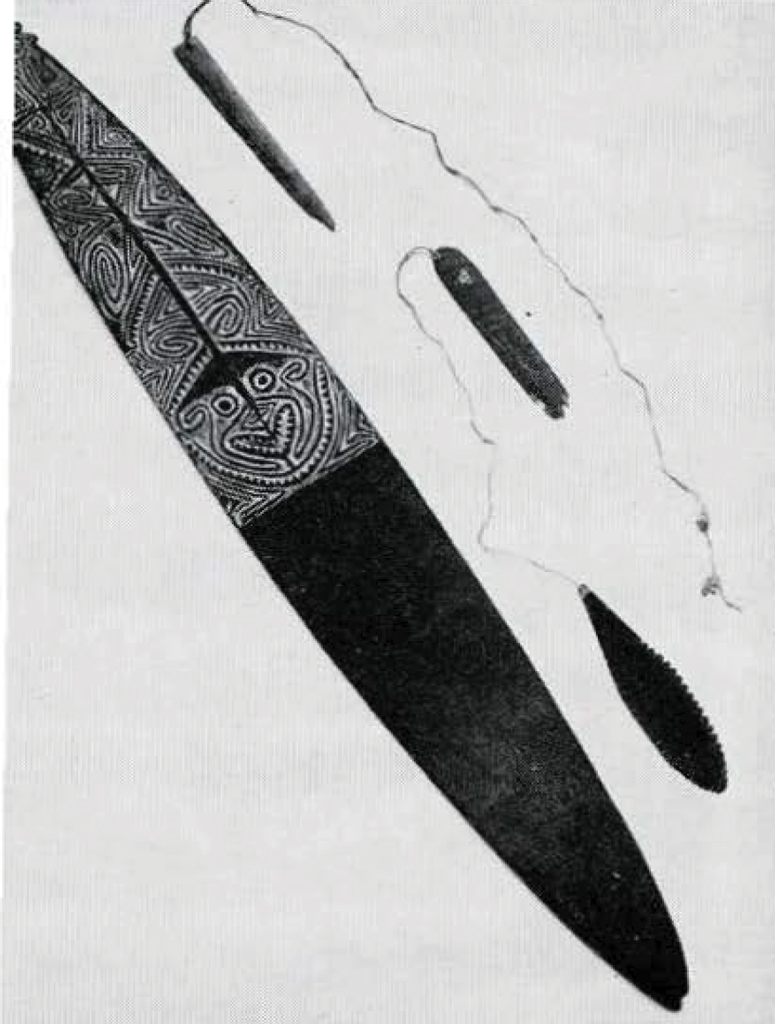
Museum Object Numbers: NA6685 / 22610
Image Number: 46954
Occasionally, frame drums occur with snares, i.e., cords either with or without attached rattling agents which pass along the surface of the head and vibrate when the drum is struck. The Sekani drum had a double snare under its membrane which could be tightened or loosened by means of the player’s thumb within a noose. The Montagnais and Naskapi drums, with a hoop and frame construction, have snares with bird quills, wood, or small bones attached, which vibrate against the membrane and whose position may be interpreted by the initiated as a fortune-telling device. As a parallel to the use of snare appendages as a divining instrument, the Lapps drew designs on their membrane which depicted gods and the sky, the lower world, and the earth. By causing a ring or something of the sort to move freely over the surface of the drum and observing on what figure it stopped, a wizard could give information about persons and things above, below, or upon the surface of the earth. Siberian frame drums frequently have metal jinglers attached inside of the frame which act in the same manner as do snares by adding an extraneous sound to the throbbing beat.
In function, the frame drum with a single head is used as an accompaniment to the shaman while curing, as rhythmic accompaniment for secular songs, and as a part of the attendant hubbub of the gambling games. The Thonga-Zulu and the Siberian shamans use this drum in their exorcism practices in common with the shamans of many North American tribes. The drum is usually beaten with a single stick, either a simple, unadorned piece of wood, a carved beater, or one with a padded head, the padding either ball-shaped or cylindrical.
Frame Drum with Double Head. Similar to the frame drum with a single head, the double-headed frame drum differs from this only in that the top and bottom of the orifice formed by the hoop are covered with membranes. The evidence for this drum goes back further in time than that for the single-headed drum, as it has been recorded for Babylonia, Ancient Egypt, and archaeological Peru. In more modem times, drums of this genre are found in North America, South America (Peru and Bolivia), and northeastern Siberia (Buryat and Altai). The chief parallel between Asia and orth America lies in the fact that the heads are painted with symbolic designs in both regions.
The North American usage of double-headed frame drums is centered in the Plains area, with occasional employment in California, in the Pueblo country, in the Northeast (where a different model, akin to the European snare drum is found), and among the Eskimos. While most of the American drums are constructed over a hoop, the Southwest Indians sometimes substitute a cheese box or a metal can, over whose open ends the membranes are stretched.
The frame is sometimes made in a rectangular form in California, a practice also encountered among the Bolivian Chipaya and the Mexican Tarahumar. Occasionally jinglers, either metal, sleigh bells, or deer hoofs, are attached to the drum in a manner reminiscent of that employed by the Siberians with their single-headed frame drums (Fig. 31). Snares are also found among the Chippewa, Cree, Montagnais, Penobscot, and Tete de Boule.
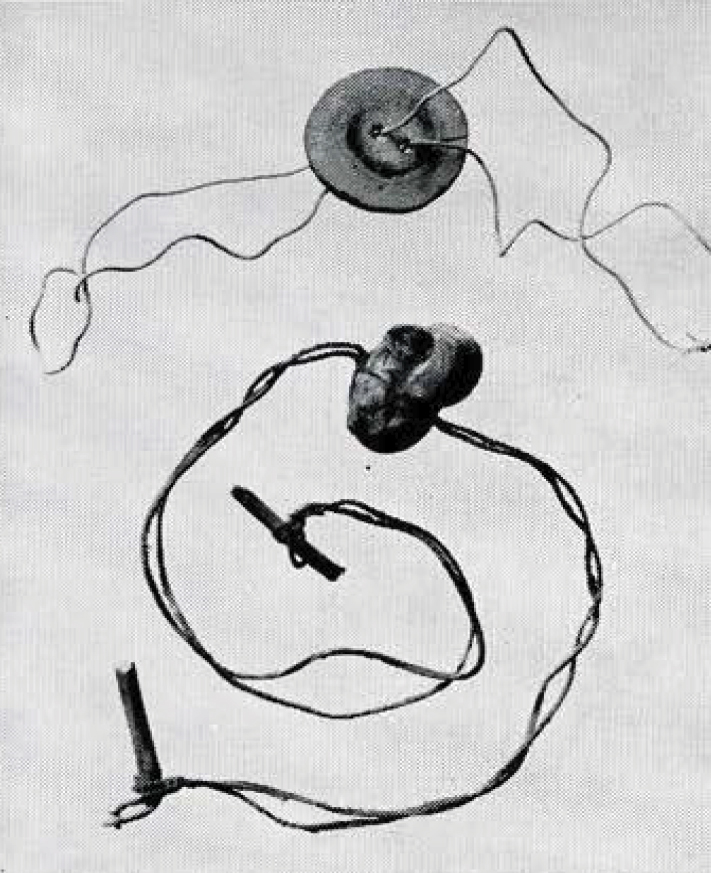
Museum Object Numbers: 38625A / 38625B
Figure 43. (lower) Bone buzz of the Naskapi.
Museum Object Number: 31-7-36
Image Number: 46955
In the secret societies of the entire Plains complex, a very large double-headed frame drum is used, usually supported on stakes, and placed horizontally in relation to the ground. These large drums are frequently beaten by a number of simultaneous drummers (Fig. 33).
Occasionally the double-headed frame drum is used, like the single-headed drum, as a shaman’s appurtenance. When this occurs, the drum is usually of a fairly small diameter, with the heads painted in shamanistic designs. These are used by the Chippewa, Cree, Dakota, Menominee, and Sioux.
The Museum of the American Indian, Heye Foundation, has a Cherokee double-headed frame drum in octagonal shape. Drums in this form are unusual, being found elsewhere in Iran, north India, and China, where they have single, not double, heads. Both these Asiatic and American drums have their frames made of eight pieces of straight wood, mitred at the corners. However, the Asiatic octagonal drums have their single heads tacked to the frame, while the Cherokee specimen has the two heads fastened together with an X-formed ligature.
Handle Drum. Frame drums are sometimes provided with a handle which either passes through the side of the frame or else fits over the edge of the frame. The handle probably originated when the drum was large and remained a feature of the construction when the drum gradually became smaller. Handle drums occur in China, East Asia, Tibet, Mongolia, India, Java, Bali, among the Siberian Chukchee, and in the entire Eskimo area of Siberia, North America, and Greenland. Despite the wide diffusion of this drum across the northern reaches of America, the Indians who were in contact with the Eskimos rarely adopted the instrument, as only the Tanaina, Tautin, and Tsilcotin seem to have employed it.
In China, divinators use drums with handles (Fig. 35), a practice that extends to the Eskimo shamans who employ it in their curing. While the Asiatic handle drums occur with two membranes, the Eskimo counterpart always has but a single head. Eskimo drums are either round, oval, ovate, or fan-shape in form, with the skin head usually held in place by a circumferential wrapping of sinew passing around the side of the frame (Fig. 34). The membrane is very thin, made of the bladder or intestine of seals or walrus. The drum is usually beaten on the wooden frame and not on the head, which acts as a resonator. In North America the only large handle drums come from the shores of Hudson Bay.
CHORDOPHONES
The instruments comprising this class produce their sound by the vibration of strings, which may be plucked, bowed, or even blown. While stringed instruments are found almost everywhere in the world, they are extremely rare in America, where only the musical bow and the tubular (Apache) fiddle were employed.
Musical Bow. This instrument is constructed of a flexible, usually bent, stick whose two ends are connected by a string. This string is set into motion by being struck with one or two small sticks, by being plucked, or by being rubbed. In most cases, the string is not fingered to change the pitch. Musical bows occur in many types throughout the world. They are encountered in Africa, in the Pacific Islands, and in North, Central, and South America.
For more than a half century a controversy over the origin of the American musical bow has raged, with an almost equal division of authorities in favor of indigenous invention or African influence. The writer believes that two streams influenced the American bow, the eastern portion of the American hemisphere falling into the African sphere, this being, therefore, fairly recent, while the western portion seems to be more closely related to the Pacific Islands. The original form of the musical bow probably occurred in Asia, whence it travelled both east and west to arrive finally in America.
In North America, the instrument is most frequently a regular hunting bow, its use concentrated in the California area but with occasional occurrences in the Basin region and in the Southwest. Isolated examples or references credit the bow to the Shawnee and the Tlingit. This use of the hunting bow is paralleled by the Bushmen of Africa.
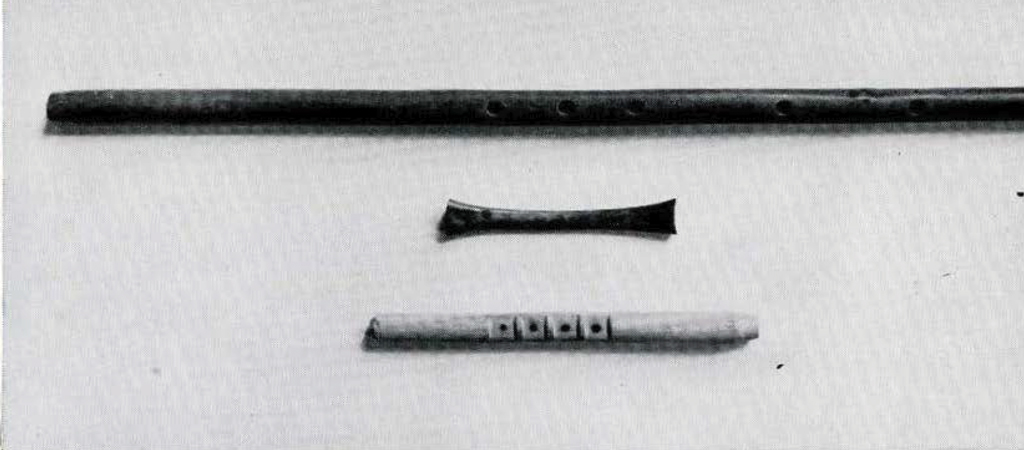
Museum Object Numbers: 28030 / 37722 / 38632
Image Number: 46956
Now, the sound produced by an instrument of this nature is exceedingly feeble and requires a resonator to make it readily audible. The resonator problem has been solved in three ways: (1) a permanent vessel (usually a gourd) is attached to the bow (Fig. 36); (2) an unconnected vessel, either a gourd, basket, or piece of wood is placed beneath the bow when it is played; (3) one end of the bow is placed in the mouth of the player, this oral resonator strengthening the sound but slightly as the tones are still quite soft, being designed for the immediate pleasure of the performer alone (Fig. 37). The hunting-bow type is most frequently held in the mouth, where, by adjusting the size and shape of the oral cavity, certain of the overtones can be reinforced, resulting in the production of limited melodies. The Zulu rest the end of their bow on the ground, while the Apache place it upon a woven basket.
Outside of America, the bow is most frequently played by striking the string with a stick, but on this continent there is an almost equal division between striking with a stick and striking or plucking with the finger. The Papago, Paiute, Pima, Shoshone, and Ute rub the string with a stick.
Some of the California tribes use a musical bow specially constructed for the purpose; one of them, the Pomo, employs a bow with two strings which resembles a double-stringed bow from the New Britain Islands.
Two non-musical usages of the musical bow are recorded. The Orinoco Indians, when fishing for alligators, strike the stretched line when the lizard takes the hook, the noise befuddling the captive saurian, which is then drawn ashore. In North America, the Havasupai drum on a bow-string during their archery game in order to make a contestant miss his mark.
AEROPHONES
This fourth and final class of instruments consists of those which produce sound through the vibration of the air itself. In most of the types of this class the vibrating air column is enclosed in a tube, but there is an entire subdivision which produces sound by direct action upon the outer air itself. This latter group is called the “Free Aerophones.”
FREE AEROPHONES
Ribbon Reeds. One of the simplest and most widely distributed wind instruments is the ribbon reed, which consists, in its simplest form, of a stretched band against which the breath strikes. This band may be a blade of grass stretched between the two grimy thumbs of a boy, a leaf inserted between the lips, or, in its more advanced form, a broad-leafed spirally-wrapped grass blade in conical form with a thin edge across one of the orifices or else ribbons of bark or some other material placed between two pieces of wood. The plotting of a true distribution chart for this instrument is almost impossible, for the very insignificant nature of the ribbon reed has caused it to be overlooked by the ethnologists.
The ribbon reed originally had magical significance. Thus it was used as a rain charm by the Taulipang of Guiana; it could attract hail in Madagascar; it was used by initiated boys as a warning for women to keep away on Karesau and Banks Islands; the Chukchee used whistles of this type in their Kere’tkun ceremony the Clallam blew their ribbon reeds at initiation ceremonies to imitate the wind and to impress the uninitiated with miraculous powers; while the Kwakiutl, Makah, and Nootka all use small whistles which they can conceal in their mouths to represent spirit voices during their great winter ceremonials. As an example of the transition from a magical to a utilitarian element, we find that the entire Rocky Mountain region, from the Mexican border to the northern reaches of Canada, employs the ribbon reed as a game decoy for deer, elk, and rabbit. At first, the sound of the lure was supposed to be the voice of the game, but later the magical connotation was lost.
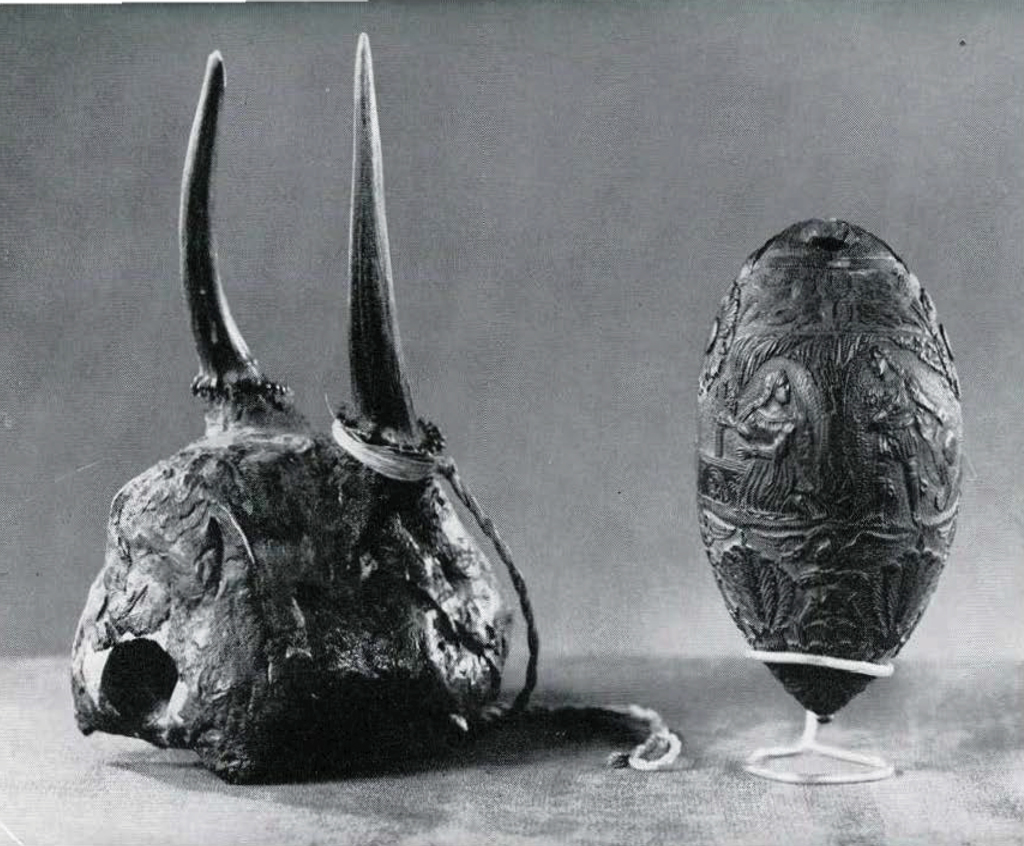
Museum Object Number: SA577
Figure 48. (left) Globular flute from deer skull. Huitoto.
Image Number: 46957
The Banks Islanders use a ribbon reed, which they call meretang, in their Sukwe initiation ceremony. This instrument is made by placing a leaf, which acts as a reed, between the two parts of a bent piece of wood. The two ends of the wood are tied together with a piece of grass. The Northwest Coast Indians make ribbon reeds, also for ceremonial purposes, by taking two pieces of wood, tying the two ends together with slices of spruce root in such a way that a cherry bark ribbon extends across the interior opening (Fig. 38).
In addition to leaves, grass blades, and bark strips, which are used as reeds both in America and abroad, other materials are sometimes utilized. The Chukchee employ an instrument of two pieces of wood with a thin piece of whalebone between in their ceremonial, where it represents the “eider-duck’s voice.” The Navaho Eagle Chant employs a whistle made of the split leg bone of the jack rabbit, the ends tied together with sinew after a piece of the inner ear of the jack rabbit is placed between the bones as a reed. The cry is supposed to represent the cry of an eagle. The Paskwawininiwug have a toy which is sometimes used as a deer call, made of a maple wood tube with a notch cut into one end, in which a piece of wet sinew is set so that it extends clown the length of the tube. Blowing into the mouthpiece end causes the sinew to vibrate against the sides of the tube, making a loud call. This instrument combines the principles of the ribbon reed and the single beating reed.
Bull-Roarer. This is an instrument made of a thin piece of wood or other material, fastened to a cord at one end so that it can be whirled around the head of the user. In addition to the plane of the swing, the bull-roarer turns around on its own axis, creating a twofold movement which permits a throbbing sound at different pitch levels, depending upon the speed of the rotation and the size of the implement itself. While most schoolboys know of such an instrument as a toy, its importance in primitive societies is very great. The sound of the bull-roarer is understood as being the voice of a spirit or a divinity, and, as such, has been accepted as a prime accessory in male initiation ceremonies in Australia, Melanesia (Fig. 39), South America, and Africa, held in such awe that it was taboo to women and the uninitiated; in fact, any woman seeing one could be put to death. In North America, the bull-roarer was not limited to male initiation rites, even though there is a tendency toward taboo among several of the tribes. The Mountain Cahuilla of California locked their children in a room with their sacred bundle if they should happen to hear the sounds of the bull-roarer; at their jimsonweed drinking ceremony they had an official who led the novitiates in dancing, whirling the ceremonial bull-roarer to keep the women and children away from the dance house at this time. The sight of the instrument was denied Pomo women and children. The Tewa of San Ildefonso used their bull-roarers out of sight, in their kivas, where women could not see them. The Wimönuntci Ute bull-roarer was also taboo to women.
This simple instrument was used almost everywhere in the world, although there are occasional places where it is not found, such as Finland, northeastern Asia (except the Chukchee), and the eastern part of North America (excluding the Mattaponi). However, its importance varies according to the prominence of the societies and the secret society initiations of the various native groups. Thus, in Australia, the bull-roarer warns the women and children that the sacred mysteries are being performed, for in most tribes it is death for the women to see the initiation ceremonies or even the bull-roarer itself. The Nandi of Africa whirl the bull-roarer to frighten boys who have been recently circumcised into staying in their huts after dark. There, no uncircumcised person and no woman may see the bull-roarer. The Eyap of Central Cameroons hold a commemorative ceremony for the dead. At a dance held some time after burial, a party of men goes through the streets, swinging the instrument, and no woman is allowed to see it. In Kenya colony, for the first month after the circumcision ceremony, the initiates are intimidated by the sounds of the bull-roarer so that they stay in their huts. In South America, the Chocó Indians use the bull-roarer to frighten evil spirits while in the forests and in northeastern Peru it is used to frighten children. Among the Bororó it plays a part in burial ceremonies. An interesting case occurs among the Apinayé, who consider the instrument simply as a toy, but who call it “me/galo,” which means the soul of the deceased.
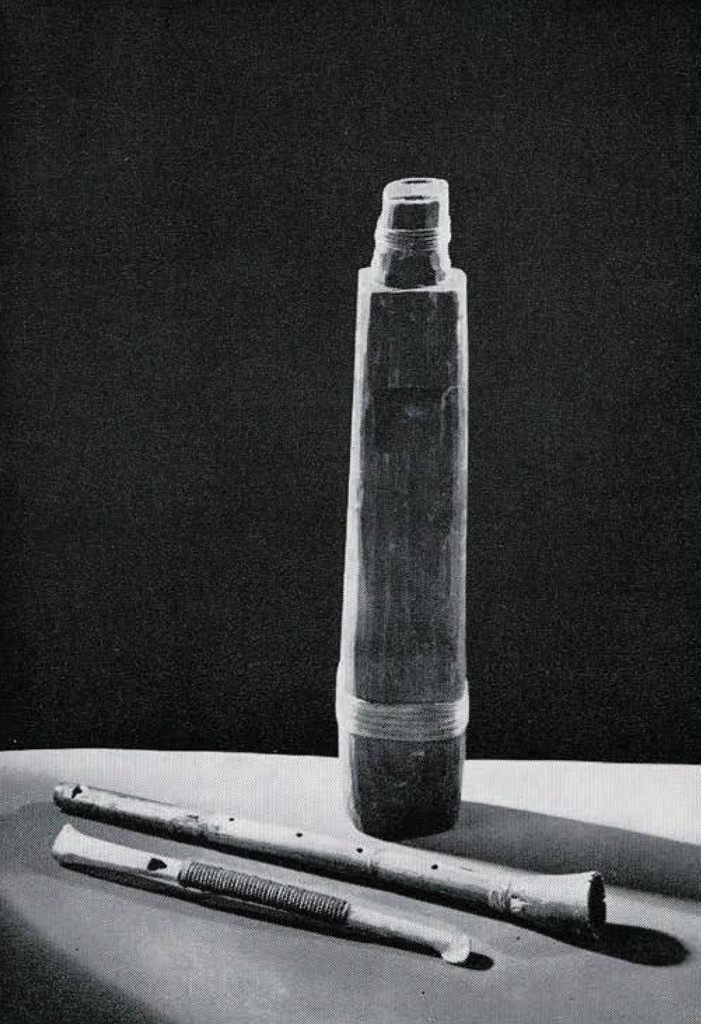
Museum Object Numbers: 45-15-1212 / NA1679 / 22660
Image Number: 46958
In North America, the bull-roarer is also widely employed in ceremonies where its connection with initiation rites represents a fertility symbolization, just as abroad. In this continent, the bull-roarer is mostly connected with the bringing of rain or warm winds to melt the winter snows, both of these to be considered as fertility symbols. The most important of these rain rites occurs among the Pueblos and adjacent tribes.
Parallel to the case of the Apinayé mentioned above, we find a widespread usage among the Basin, California, Plains, Mackenzie-Yukon, and Plateau Indians where the bull-roarer is considered as a toy; nevertheless, when it is whirred, it can bring a warm wind or rain. This reveals that the implement is in a transitional stage, between a ritual property and a mere toy.
The use of the bull-roarer as a warning signal in Australia, among the Nandi, and the Cahuilla has been described. In addition, the Zuni whiz it as a warning for the observance of ritual forms. The instrument is used as a signal for the assembling of the people among the Cupeño, Diegueño, Luiseño, Mono, Papago, and Serrano.
The bull-roarer is considered as being the voice of a god or of a spirit among the Australians, the New Guineans, the Solomon Islanders (who believe it represents the voice of a ghost which terrifies women so that they fling all their chattels to the four winds and flee precipitously to another place), the Kwakiutl, and the Pomo. It is a shamanistic accessory among the Guatuso of Central America, while it serves superstitious purposes among the Botocudo and Chocó in South America, and the Bushmen and Sudanese of Africa. In North America, the bull-roarer has curative properties among the shamans of the Diegueño, Mono, Navaho, Tonto Apache, Yokuts, Pomo, and Papago; formerly this was also true of the Tanaina. The Yavapai used it as a spirit impersonator.
The usual material for the bull-roarer is wood (Fig. 41) although in tropical regions flat, almost rigid, leaves were employed. In North America, horn was used by the Mono, Panamint, Achomawi, Southern Paiute, Shoshone, Ute, and Naskapi, while bone or deer rib was found among the Achomawi, Arapaho, Mono, Panamint, Kittitas, and Umatilla. The Ute also utilized a bull-roarer made of a strip of hide. The Eskimos, in addition to wood, used baleen (Point Barrow), whalebone (Sadlermiut), and ivory (Sikosuilarmiut and St. Michael) (Fig. 40).
Buzz. Made of a disk, an irregular chunk of solid matter, or a blade, the buzz is fastened in most instances to a looped cord, so that it can be spun rapidly back and forth by the twining and untwining of the loop under tension from the hands. It is probably related to the bull-roarer in its origin. As proof of this we find the South American Carajá using it as a male instrument at their masked dances; the Indians of the Rocky Mountain regions use it as a charm to bring rain, snow, warm weather, favorable winds-i.e., as a fertility charm, a practice that extends to the Navaho in the Southwest, the Eyak in the Mackenzie-Yukon area, and the Naskapi in the Northeast. The buzz is used, too, by the Zuni War Priests as a warning, just as is the bull-roarer in many regions. Another point of contact between the buzz and bull-roarer may be found in its restriction to the males alone. This takes place among the Carajá of Brazil, as mentioned above. The Ingalik, who supposedly use it as a toy occasionally for boys or men, limit it to daytime use in the summer, revealing a lost symbolism. The Sekani, Shawnee, and Oglala Sioux restrict it to the mere status of a boy’s toy.
In addition to this functional similarity between these two free aerophones, certain buzzes are made in a blade form that differs primarily from the bull-roarer in that the former has two holes bored in the center for the passage of a loop, while the latter has a single hole drilled at one end for the insertion of the string by which it is whirled. The blade-formed buzz is found among the Lapps, the Siberian Yakuts, and the Greenland Eskimos-among whom the implement is sometimes made with a twisted axis like an airplane propeller. The blade sometimes becomes a flattened rectangular shape, with the usual two perforations in the center, as with the Cree, the Africans of Togo, the Japanese bun bun, and the western Eskimos at Utkiavi, Alaska. However, in principle, the buzz differs from the bull-roarer in that the instrument spins in only one plane, around its axis.
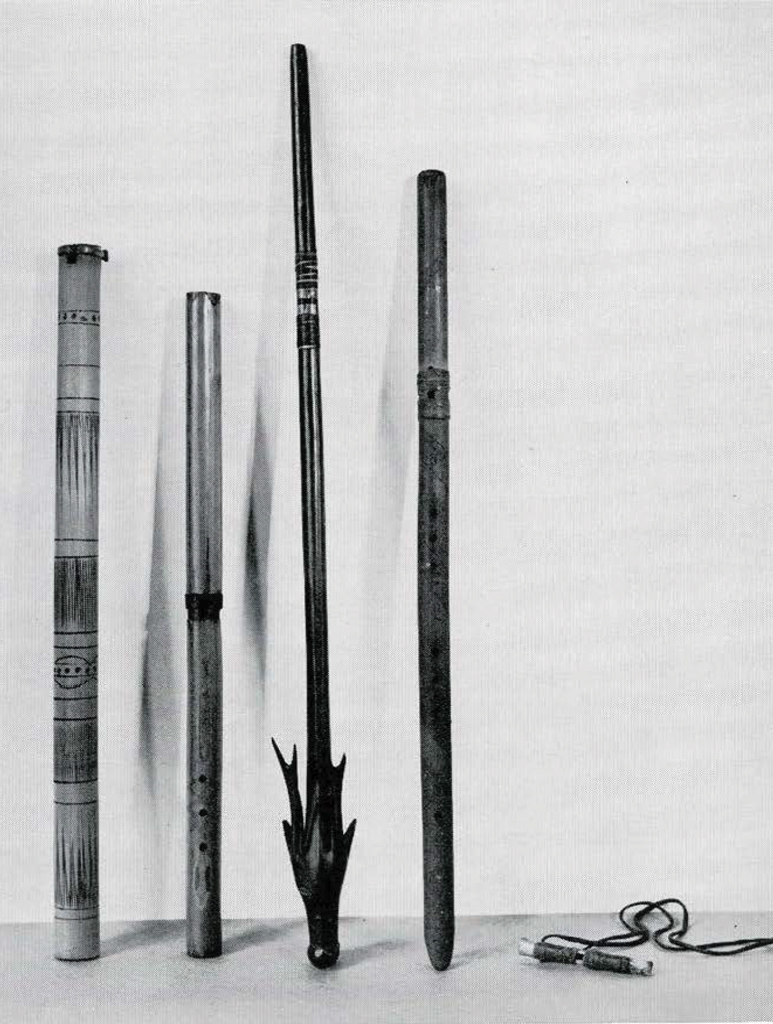
Museum Object Numbers: 45-15-1207 / 45-15-1215 / NA1726
Image Number: 46960
The disk-fomed buzz occurs in many materials, the most common being manufactured of wood with the outer edges either serrated or plain, just as is true of the bull-roarer. The wooden buzz disk is found in China, in Togoland, in Hungary, and among the Maori, the California tribes, the Southwestern Indians (Apache, Navaho, Tewa of Santa Ana, and Zuni), the Teton Sioux, the Paiute, Panamint, Ute, Eyak, Ingalik, Saulteaux, and Thompson tribes. They are made from sections of gourds by the Carajá, Catawba, Mohave, San Ildefonso, Santa Ana, and Zuni. Similar in concept to the gourd buzz disks are those made of pumpkin shell, as found among the Apache, Hopi, and Zuni. Buzzes made of bark or leaves were used by the Pangwe (a piece of the bark of a raphia stem), the California tribes, the Mohave (whose myths tell of the use of a cane buzz), and the Papago (who found a saguaro rib suitable for their purpose).
Another adaptation of the disk form occurs in Hungary and in the southern part of the Northwest Coast of America, where buttons of shell or wood were used as buzzes by passing the looped cord through their central perforations. This same form also occurs in North America and among the Chukchee, where hide or even shoe leather buzzes are found. The hide disk is found mostly in the California area and among the Eskimos of north-central Canada. The Chukchee also use the stiff skin of a fish for the purpose. Other disk forms occur in North America: stone in the Pueblo region (Fig. 42) and among the Kinepetu Eskimo; pottery, also in the Pueblos; and shell in California.
Irregularly shaped buzzes made from bones or hoofs of animals are mounted on sinew cords which are “wound up” to permit the spinning of these objects (Fig. 43). In Hungary, swine bones are used, while the Asiatic Kirghiz employ sheep bones. In America, the use of bones is as widespread as that of the disk type and, in many instances, even occurs among the same tribes. The Eskimos use ivory, usually in a blade form. The Iglulik Eskimo make a buzz of the small vertebra of a white fish with sinew threads through the two longitudinal canals so that it can be spun. The Mono and the Yokuts even buzzed rattlesnake rattles.
Fruit shells and seeds are sometimes pierced for the placing of a loop so that the implement can be used as a buzz. When this occurs, the result is a blend between the disk and the irregularly shaped type. This takes place in China, where nutshells are glued to a wooden disk, each shell with a split cut into it so that it whistles when spun rapidly. Empty seed pods are used in South America and split-palm seeds in Java. In North America, the Miwok, Wintun, and Yokuts use acorn shells as these humming toys.
TRUE AEROPHONES
The true aerophones are those instruments whose vibrating air column is enclosed within a tube or a vessel. The air column is set in motion by the breath of the player by being directed against a sharp edge (flute), by the back-and-forth movement of a single reed (clarinet) or a double reed (oboe), or else by the vibrations of the lips of the player (trumpets and horns). In North America, the single reed type and the horns are rarely found.
Vertical Flutes. These are instruments held more or less perpendicularly to the ground, with the upper opening supplying the sharp edge against which the breath of the player is directed. Such flutes occur either with or without finger stops, which are openings in the side of the tube to be left open or else closed by the fingers as a means of altering the length of the tube, an action which permits different pitches.
The North American vertical flutes, limited to California, the Southwest, the Plateau, and the Basin areas, apparently never have stops on the dorsal side which could be fingered by the thumb. The appearance of thumb stops is considered as a later development. Yet, we find innumerable specimens of flutes with thumb stops among the archaeological finds from ancient Peru, where the vertical flutes always have thumb stops (Fig. 44). However, flutes without thumb stops are found elsewhere in South America as well as in Siam, Borneo, Sumatra, Egypt, Algeria, Morocco, British East Africa, and Uganda.
Wood, cane, or the bones of animals or birds are the most common materials for these flutes. In North America, wood is the most frequently employed, with cane also used in the warmer regions of this area. Bone, too, is found here, but not so often as the other materials. In North America, the four-stop vertical flute is most common, with six-stop ones next in frequency. In central California, the stops are burned through the side of the tube in a section where the side wall has been flattened by being planed down (Fig. 45). This same thinning of the wall occurs in South America among the Lengua and Chorotí and on the Marquesas Islands in the Pacific.
The flute is the only American instrument with truly musical possibilities, since the finger stops permit the playing of real melodies. As a result, the flute is used for non-ceremonial purposes, being played for pure amusement or for the serenading of one’s true love. Exceptions to this are found only among the Pueblos, who use the vertical flute in their ceremonies (Fig. 46).
Globular Flutes. Differing from the more usual tubular flutes in being made of a closed vessel with a mouth-hole cut into one end, globular flutes were originally made of such natural materials as gourds, coconuts, or other fruits (Fig. 47); they are found in Africa, Asia, the Pacific, and both Americas. Later, the natural form was imitated in other materials in Africa, Asia, and Peru. In North America, the globular flute occurs in only one area, Virginia-North Carolina, where the Chickahominy, Pamunkey, Nansamond, and the Siouan-speaking group of Robeson County, North Carolina, use gourds for this purpose, the last two tribes employing them only without finger stops, the first two possessing them both with and without stops. Interesting examples of the transition from natural materials to pottery forms occur at Quintay, Peru, where the fruit shape has been carried over into clay. An extremely exotic form is that of the Huitoto, who use a deer skull with the horns still attached, filling up the cavities with pitch to make an air-tight vessel (Fig. 48).
Deflector Flutes. Certain flutes produce their sounds by the air current being directed through a mechanical device instead of progressing directly from the mouth of the player to impinge upon the sharp edge. Deflector flutes fall into three classes: (1) simple deflector flutes in which the mouth end of the tube serves as a duct leading the air stream to an internal deflector block which directs the air to the sharp blowing edge; (2) deflector flutes with partially covered orifice, constructed like the simple deflector flutes except that the opening over the deflector is so large that it requires an overlay of some material which serves as an extension of the side wall of the flute; (3) deflector flutes with entirely covered orifice in which the mouth end leads to a growth node or an inserted plug, the top of which is cut down slightly so that it is lower than the side of the tube. Lateral openings are cut into the wall, one on each side of the plug, and the entire area is covered with a solid block so that the air stream is bent upward by the deflecting plug and then directed by the covering piece toward the further lateral opening, which serves as the blowing edge. This type of flute is a Mexican-North American element.
Simple Deflector Flutes. These are simple whistles with the blowing edge usually toward the central part of the tube. They are widely used in the western half of North America, where they are almost always connected with ceremonies (Fig. 49). The American examples are most frequently made from the long, hollow wing or leg bones of birds, but occasionally wood or cane is used. The latter two materials are employed in Egypt and South America. Modifications of these simple deflector whistles are found among the Northwest Coast Indians, who tie two pieces of wood together in shapes ranging from cylindrical tubes to vessels with fantastic carvings (Fig. 50). The Oklahoma Delaware use a long tubular neck gourd as a whistle.
Sometimes the simple deflector whistle is made with finger stops. These are found all through the Islamic area, in Borneo, Japan, China, the Pacific Islands, and South America. In North America, they are limited mostly to the Pueblos (Fig. 51), with occasional occurrence on the Plains. Northwest Coast slate flutes are modern.
Deflector Flutes with Partially Covered Orifices. Flutes of this class have their extensions to the side wall tied on either above or both above and below the orifice. These additions are made of split quill, bark, leaf, or wood. The type is heavily concentrated in the two Americas, on Mindanao and Celebes, and among the Dyak of Borneo. Bones of birds, rodents, or larger mammals furnish the tube for the Achomawi, Nisenan, Kitksan, Kutenai, and Sanpoil-Nespelem, but are never employed in South America for flutes of this construction. Wood is used by the Plains Indians, the Nisenan, Sanpoil-Nespelem, and Shoshone, while cane or reed is found among the Midwestern tribes, the Plains groups, and the Choctaw. Both of these materials are common in South America. The deflector is made of the natural internode, while pitch, wax, resin, or wood is inserted in the bone or wood flutes of both Americas.
Deflector flutes with partially covered orifices occur without stops in both Americas. The Tuyuka use the largest flute of the hemisphere in their Yurupari festival. The upper and lower edges of its orifice are covered with leaves tied to the instrument, the sound being directed to them by a wax deflector placed within the Paxiuba palm trunk section which serves as the tube. The Yurupari ceremonies are celebrated by the secret men’s societies, and these flutes, together with bark trumpets, are taboo from even the sight of women and children. Considering the parallels with this instrument, we find that all South American flutes of this type have two extensions to cover the upper and lower edges of the orifice. These are made of leaves, bark, or strips of bamboo. In North America, either one or two of these covering plates may be used; when single, they occur at the upper edge of the orifice and are made of wood, bark, split quills, or wrappings of leather bands or strips. The North American deflectors, like those of South America, are made with the natural internode in the case of cane flutes and, in the wood and bone examples, of inserted blocks of pitch, resin, wax, wood, and, in the case of the Kitksan, bark.
The function of the North American stopless flutes is similar to that of those from South America, although the taboo element is either absent or else barely emphasized. In the northern continent they are used in ceremonial dances (Fig. 52) and are attached to the ceremonial bundles on the Plains and in the Midwest. They are used by sucking shamans among the Achomawi, while Kutenai and Kitksan medicine men employ them in curing (Fig. 53). The Museum of the American Indian, Heye Foundation, has a Kitksan specimen made of eagle bone with the sound orifice wrapped at its upper edge with strips of leather thong, and the deflector is of bark. The whole instrument is carved to represent a mythical water monster sacred to the shaman who uses it when practicing around the sick. The Sanpoil-Nespelem reveal a rare use for this flute without stops when the lover signals his presence to his sweetheart with it and later amuses her by producing certain limited melodies consisting of the different overtones which are selected by altering the force of blowing. The function of lover’s accessory is common to the flutes with stops but is very rare for those lacking the finger holes.
Flutes of this type also occur with stops. In South America they are limited mostly to Brazil, where they are made of the same materials and in the same manner as those without stops. They usually have four frontal stops, although they sometimes occur with five frontal and one dorsal stop. They are apparently used for amusement. In North America, they are most frequently made of cane (Fig. 55), wood being a secondary choice. Here, the stops range from two (Choctaw) to seven (Hopi) (Fig. 54), with four stops being the most frequent, closely followed by six as a favorite number. The North Americans use these flutes for courting, amusement, or as toys, although the Choctaw play them in their Ball Play ceremonies. The extensions covering the orifices are either single or double, with strips of cloth or leather more frequently used than the tying on of a flat sliver of wood or leaf. In addition, the Apache and Pima use a finger as a covering plate.
Two curious parallels arise with these flutes. Many of the South American examples have the internodes at each end still in place. Both of these septa are perforated. The same feature of construction is found also with the Papago, Pima, and Yuma Indians of North America. The second feature is the practice of wrapping the tube over the orifice with a band of cloth or leather, the wrapping serving as the extension of the side of the tube. This is reminiscent of the band-flutes of the Tibetan-Burmese-Malayan sphere, where the upper part of the side wall is shaved down and then wrapped with rattan or palm-leaf so that there is a channel left between the wrapping and the wall itself (Fig. 56). The chief difference between the Asiatic and the American types is that the blowing edge of the former is close to the upper end of the flute, requiring no deflector, while that of the latter is placed toward the center, thus necessitating the deflector.
Trumpets and Horns. Both trumpets and horns are aerophones which produce sound by the air current causing the edges of the lips to vibrate, thus directing the pulsations into a tube or vessel. The distinction between trumpets and horns is difficult to make, going back to the origins of the types; those instruments which were originally made from the horns of animals and were, therefore, curved in shape with a more or less conical bore are called horns; those which are long, narrow, and straight, descending from a hollow bamboo or branch and with a more or less cylindrical bore, are called trumpets.
The probable origin of the class lies in magic rather than in music. Early, superstitious man took a hollow tube which he used as a megaphone or speaking trumpet, not for blowing a note, but for masking his voice so that it would be less human, more supernatural and, thus, more efficacious in frightening away evil spirits. We find this to be true among the Loango of Africa, as well as in Australia, Melanesia, and Brazil. The Botocudo of Brazil use the tail of a giant armadillo, which has a cow-horn shape, for this purpose. In North America, we find the use of kelp speaking trumpets among the Kwakiutl and Nootka. The Kwakiutl. especially, have a very elaborate ritual in which the kelp tubes are buried before the ceremony, with one end beneath the fire and the other end concealed in an apartment away from the main room. Many voices of spirits are then heard emerging from the fire. The same people also call the northwest wind by summoning it up with the aid of a kelp speaking tube. The Cumberland Sound Eskimo have a myth in which a Cannibal took his daughter’s thigh bone and used it for a speaking trumpet to call the people. There is also a Tsimshian myth wherein a group of besieged men, who had carved human forms out of wood, connected kelp speaking tubes from an upstairs room to trick their besiegers into believing that there was still a large body of men alive and ready to fight.
The effect of masking the voice and, later, the sound, when the instrument became a true trumpet, was frequently enhanced by placing the lower end of the instrument in a resonator. Many Loango magicians used a giant wooden speaking tube which produced a frightful howl. Its effect was increased by pointing the end toward the ground, toward the heavens, or placing it in a humming keg or against a hut wall. On the New Hebrides Islands, tree trunks or water-filled coconut shells were used; in northwestern Brazil, the tube is placed in a clay vessel; in Nicaragua, the Misquito Indians blow upon a bamboo tube inserted into an iron pot. In North America, the Hopi place the end of a gourd trumpet in a basin of water when they blow upon it.
The transition from speaking tube to true trumpet is clearly seen among the Kwakiutl, for at the Koskimo winter dance, during the evening preceding the ceremonies, a number of boys are sent out to gather kelp. They return during the night, blowing on these tubes, producing a sound like that of large horns.
In North America, the majority of the trumpets are made of birch bark wrapped spirally into a conical form. These occur mostly in the northeastern part of the continent with the Beaver, Beothuk, Malecite, Micmac, Montagnais, and Penobscot. They are also found to the west, where the Cree, Chipewyan, and Slave Indians all use them. These bark trumpets are used as game decoys for luring caribou and moose. It is not possible to say if there is any magical symbolism remaining in this usage. In South America, trumpets of bark occur in the Guiana-northern Brazil region, where they are feared by women. Bark trumpets occur in profusion in Europe, and they are also found in New Zealand and portions of Siberia.
Horns made of conch shells, which are found almost everywhere in the world, are very rare in North America. The Zuni blow them in connection with their Horned Water Serpent Dance. It is likewise a fetish for the Rain chieftaincy. The union of the conch shell and rain, as fertility symbols, is very widespread. In Central Europe, even today, it is blown into the wind during thunderstorms. In India, it becomes an attribute of Vishnu, and, in Ancient Mexico, of Tlaloc, both of whom were moon-gods, i.e. fertility symbols.
CONCLUSION
The preceding survey of parallels with North American Indian musical instruments has shown similarities of one kind or another. These similarities are of form, material, or function. It is obvious that in many cases coincidence has been responsible for the apparent duplication, controlled by the presence of the material at hand. But, in many other cases, the combination of two or more of the listed similarities reduces the possibility of coincidence, suggesting the inter-relation of these different civilizations. It is here that the diffusionist detective follows his clues most ardently.
* All the objects reproduced to illustrate this article, unless otherwise noted, are from collections of the University Museum. The photographs arc by Reuben Goldberg. ↪

